Quote Investigator®
Tracing Quotations

I Would Spend 55 Minutes Defining the Problem and then Five Minutes Solving It
Albert Einstein? A Yale Professor? Apocryphal?

If I had only one hour to save the world, I would spend fifty-five minutes defining the problem, and only five minutes finding the solution. If I had an hour to solve a problem I’d spend 55 minutes thinking about the problem and 5 minutes thinking about solutions. Given one hour to save the planet, I would spend 59 minutes understanding the problem and one minute resolving it.
Because there are so many different variations I do not have much confidence that this was actually said by the acclaimed genius. Would you please explore this expression?
Quote Investigator: There is no substantive evidence that Einstein ever made a remark of this type. It is not listed in the comprehensive collection “The Ultimate Quotable Einstein” from Princeton University Press. [1] 2010, The Ultimate Quotable Einstein, Edited by Alice Calaprice, Princeton University Press, Princeton, New Jersey. (Examined on paper)
The earliest relevant evidence located by QI appeared in a 1966 collection of articles about manufacturing. An employee of the Stainless Processing Company named William H. Markle wrote a piece titled “The Manufacturing Manager’s Skills” which included a strong match for the saying under investigation. However, the words were credited to an unnamed professor at Yale University and not to Einstein. Also, the hour was split into 40 vs. 20 minutes instead of 55 vs. 5 minutes. Boldface has been added to excerpts: [2] 1966, The Manufacturing Man and His Job by Robert E. Finley and Henry R. Ziobro, “The Manufacturing Manager’s Skills” by William H. Markle (Vice President, Stainless Processing … Continue reading
Some years ago the head of the Industrial Engineering Department of Yale University said, “If I had only one hour to solve a problem, I would spend up to two-thirds of that hour in attempting to define what the problem is.”
Albert Einstein died in 1955, and by 1973 a version of the saying had been assigned to him in an article in the journal “Invention Intelligence” based in New Delhi, India. Interestingly, the hour was split into three parts instead of two. No supporting data for the attribution was given: [3] 1973 August, Invention Intelligence, Volume 8, Number 8, Can I Learn to Invent? by A. M. Elijah (Director, Institute of Creative Development, Poona-1), Start Page 294, Quote Page 297, Issued by the … Continue reading
Often the problem as given is misleading, and you have to work through a mass of data to define the real problem. Often this step consumes more time than deriving the solution. Einstein said: “If I were given an hour in which to do a problem upon which my life depended, I would spend 40 minutes studying it, 15 minutes reviewing it and 5 minutes solving it.”
Here are additional selected citations in chronological order.
In 1986 an instance of the saying was attributed to Einstein in a paper published in the conference proceedings of the International Association of Quality Circles. The hour was split into two parts. The phrase “Einstein is reported to have said” suggested that the author did not have much confidence in the ascription: [4] 1986, Educational Transactions of the 8th Annual IAQC Spring Conference, “Creatively Managing Your Mind” by Robert J. Greene (IBM Corporation), Start Page 62, Quote Page 68, Published by … Continue reading
Einstein is reported to have said that if he only had one hour to solve a problem he would spend 55 minutes defining the problem and the remaining 5 minutes solving it routinely.
In 1989 “The Practical Guide to Joint Ventures and Corporate Alliances” was published, and the author presented an instance attributed to Einstein. This version once again split the hour into three parts: [5] 1989, The Practical Guide to Joint Ventures and Corporate alliances by Robert Porter Lynch, Chapter 13: Problems and Pitfalls in Strategy and Structure, Quote Page 225 and 226, John Wiley & Sons, … Continue reading
Albert Einstein was once asked how he would spend his time if he was given a problem upon which his life depended and he had only one hour to solve it. He responded by saying he would spend 30 minutes analyzing the problem, 20 minutes planning the solution, and ten minutes executing the solution. For those overly prone to jumping into action, a bit more planning would be worthwhile.
Skilled researchers Jesse Mazer and Barry Popik have also examined this saying and some of their findings have been incorporated in the next section. [6] Website: Wikiquote: Discussion Page, Webpage Title: Talk: Albert Einstein, Discussion topic: If I had only one hour to save the world, I would spend fifty-five minutes defining the problem, and only … Continue reading [7] Website: The Big Apple, Article title: “If I had an hour to solve a problem, I would spend 55 minutes thinking about the problem”, Date on website: May 06, 2014, Website description: Etymological … Continue reading
In 1995 the book “Creative Problem Solving and Opportunity Finding” printed an instance of the expression in which Einstein was called upon to save the world: [8] 1995, Creative Problem Solving and Opportunity Finding by J. Daniel Couger, Chapter 6, Quote Page 178, Boyd & Fraser Publishing Company, Danvers, Massachusetts, A division of International … Continue reading
Dewey believed that a problem well stated was half solved. Albert Einstein was even more emphatic about the importance of the definition of the problem. He was once asked: “If you have one hour to save the world, how would you spend that hour?” He replied, “I would spend 55 minutes defining the problem and then five minutes solving it.”
In March 1995 “The Orange County Register” newspaper of California printed the remarks of a management professor at McMasters University in Ontario who credited Einstein with an instance of the saying: [9] 1995 March 19, The Orange County Register, Section: Business, “BUSINESS FIND A NEW TOOL: CREATIVITY – STRATEGIES: More companies are encouraging creative thinking in order to remain … Continue reading
While brainstorming and problem solving are important, it’s equally critical to pinpoint the exact problem, Basadur said. “When Einstein was asked how he would save the world in one hour, he said he’d spend 55 minutes defining the problem and five minutes solving it,” Basadur said.
A 2012 book about the talents needed by workers in the robotic age presented a dramatic scenario for the time limit and suggested that Einstein delivered his remarks during an interview: [10] 2012, Metaskills: Five Talents for the Robotic Age by Marty Neumeier, Unnumbered page, Published by New Riders, an imprint of Peachpit, a division of Pearson Education. (Google Books Preview)
In another interview he said that if he knew a fiery comet was certain to destroy the earth in an hour , and it was his job to head it off, he would spend the first fifty-five minutes defining the problem and the last five minutes solving it.
An interesting analogous statement has been spuriously attributed to another eminent person. The following remark about preparing to perform a task is usually assigned to Abraham Lincoln. An examination of its provenance is available by following this link :
Give me six hours to chop down a tree and I will spend the first four sharpening the axe.
In conclusion, currently there is no known substantive support for the claim that Albert Einstein made one of these remarks. The earliest evidence points to an unknown academic at Yale University who may have made the statement given in the 1966 citation. The popular expression has been evolving for decades leading to a creative efflorescence of inaccuracies.
Image Notes: Albert Einstein during a lecture in Vienna in 1921 via Wikimedia Commons. Clock face showing 55 minutes from OpenClips on Pixabay.
(Myriad thanks to John McChesney-Young for obtaining scans of the important 1973 citation. Great thanks to Don MacDonald and the librarians of the Harvard Business School for obtaining scans of the key 1986 citation. Many thanks to Barry Popik whose previous research and query led QI to formulate this question and perform this exploration. Special thanks to Jesse Mazer for his valuable work tracing Einstein attributions at Wikiquote.)
Update History: On June 20, 2014 the 1973 citation was moved from the appendix into the main body of the article. This movement occurred after the citation had been verified with scans.
Albert Einstein: 'It's not that I'm so smart, it's just that I stay with problems longer.'
It's not that I'm so smart, it's just that I stay with problems longer.
The quote by Albert Einstein, 'It's not that I'm so smart, it's just that I stay with problems longer,' carries a deep and meaningful message. At first glance, it may seem like a simple statement about perseverance and dedication towards problem-solving. Einstein acknowledges that his intelligence alone is not what sets him apart, but rather his willingness to persist and delve deeper into the complexities of problems that come his way.This quote emphasizes the importance of persistence and commitment in unraveling the mysteries of life. It reminds us that intelligence alone is not always enough to achieve great feats; it is the tenacity to stick with a problem and explore all possible angles that truly enables progress.However, let us delve deeper into this quote by introducing an unexpected philosophical concept - the notion of surrendering to the flow of life, also known as "wu wei" in Chinese philosophy. Wu wei can be translated as "non-doing" or "effortless action," and it suggests that the most effective way to handle situations is by letting go and allowing things to unfold naturally, rather than forcefully trying to control every outcome.By considering the concept of wu wei in relation to Einstein's quote, we can see an interesting contradiction. On one hand, Einstein suggests that the way he succeeds is through unwavering dedication, perseverance, and staying with problems longer. On the other hand, wu wei teaches us to surrender and let go of our attachment to results, encouraging us to trust the process and allow solutions to arise effortlessly.These two perspectives may seem conflicting, but they can coexist harmoniously. When faced with a problem, the initial spark may come from actively engaging with it, putting in effort, and staying determined to find a solution. But as we immerse ourselves in the process, wu wei invites us to detach from our preconceived notions, expectations, and the desire to control outcomes.By combining Einstein's perseverance and dedication with the philosophy of wu wei, we can strike a balance between active engagement and surrender. We can persistently work on challenges, continuously seeking answers and exploring different approaches, while simultaneously embracing the randomness, uncertainty, and serendipitous nature of life.Moreover, this contrast between Einstein's determination and wu wei's surrender highlights the multidimensionality of problem-solving. It invites us to reflect on the dynamic interplay between active effort and passive receptivity. Sometimes, it is not solely about staying with a problem longer, but also about allowing the problem to unveil its hidden secrets by quietly observing, listening, and tuning into the subtle cues of the universe.In conclusion, Albert Einstein's quote holds great significance in emphasizing the importance of dedication and persistence in problem-solving. However, when we introduce the concept of wu wei, we discover an intriguing contrast that challenges our conventional understanding of how to approach problems. By embracing both sides of this equation - actively staying with problems and surrendering to the natural flow of life - we can unlock new perspectives and deeper insights. So, let us remember Einstein's wisdom and combine it with the philosophy of wu wei as we embark on our own quest for knowledge and understanding.
Isaac Asimov: 'A subtle thought that is in error may yet give rise to fruitful inquiry that can establish truths of great value.'
Albert einstein: 'anyone who has never made a mistake has never tried anything new.'.
Albert Einstein Quotes Problem Solving
MS Lina Pierce
Albert Einstein, the genius physicist and Nobel laureate, is renowned not only for his groundbreaking scientific theories but also for his profound and insightful quotes. His wisdom transcends the realm of science, shedding light on fundamental aspects of the human condition. Among his most impactful words are those related to problem-solving. Einstein’s quotes on this topic offer a unique perspective, emphasizing the importance of innovative thinking, the necessity of understanding problems deeply, and the need for a shift in mindset to find effective solutions. This blog post will delve into some of Einstein’s most thought-provoking quotes on problem-solving, each followed by a brief explanation to help us apply his wisdom in our daily lives.
Albert Einstein Quotes Solving Problems
- “If I had an hour to solve a problem I’d spend 55 minutes thinking about the problem and five minutes thinking about solutions.” This quote emphasizes the importance of understanding a problem thoroughly before jumping to solutions.
- “We cannot solve our problems with the same thinking we used when we created them.” Einstein suggests that to solve a problem, we need to change our mindset and approach.
- “The world as we have created it is a process of our thinking. It cannot be changed without changing our thinking.” This quote underscores the power of our thoughts in shaping our reality and the necessity of changing our thinking to bring about change.
- “A clever person solves a problem. A wise person avoids it.” Einstein differentiates between cleverness and wisdom, implying that foresight and wisdom can prevent problems from arising in the first place.
- “You never fail until you stop trying.” This quote encourages persistence in the face of challenges and problems.
- “The measure of intelligence is the ability to change.” Einstein suggests that adaptability and the ability to change one’s thinking are key indicators of intelligence.
- “If I had an hour to solve a problem and my life depended on the solution, I would spend the first 55 minutes determining the proper question to ask, for once I know the proper question, I could solve the problem in less than five minutes.” This quote highlights the importance of asking the right questions in problem-solving.
- “Problems cannot be solved at the same level of awareness that created them.” Einstein emphasizes the need for a higher level of thinking or awareness to solve problems.
- “It’s not that I’m so smart, it’s just that I stay with problems longer.” This quote reflects Einstein’s humility and his persistence in problem-solving.
- “Learn from yesterday, live for today, hope for tomorrow. The important thing is not to stop questioning.” Einstein encourages continuous learning and curiosity as key to problem-solving.
Albert Einstein’s quotes on problem-solving offer timeless wisdom. They remind us of the importance of understanding problems deeply, changing our mindset, and persisting in the face of challenges. As we navigate through life’s complexities, these insights from one of the greatest minds in history can guide us towards effective problem-solving and decision-making.
Related Posts:
- Albert Einstein Quotes Change
- Birthday Wishes 1st Birthday
- Thank You Note to Speaker at Conference
- Albert Einstein Quotes About God
- Internal Audit Quotes Every Auditor Needs to Know
- Happy Anniversary to Aunty and Uncle Anniversary Wishes
About the author
Featured Posts
Rumi quotes on art.
Art is a language that transcends boundaries, and no one understood this better than the 13th-century Persian poet, Jalal ad-Din Muhammad Rumi. His profound wisdom and spiritual insights have inspired countless artists and creatives over the centuries. This blog post delves into the world of Rumi’s wisdom, exploring his perspective on art, creativity, and the…
Funny Angel Puns That Will Make You Laugh
If you are looking for a little bit of levity in your day, you have come to the right place. This blog is all about light–hearted content that will make you smile. Check out our collection of angel puns! From heavenly hilarity to devilish fun, these puns are sure to put a smile on your…

Einstein’s Secret to Effective Problem-Solving
Deep understanding of the problem, by philmckinney.
Albert Einstein once said, “If I had an hour to solve a problem, I'd spend 55 minutes thinking about the problem and five minutes thinking about solutions.” This quote is more than just a clever remark; it encapsulates a fundamental truth about problem-solving that many overlook. It emphasizes the importance of deeply understanding a problem before attempting to solve it.
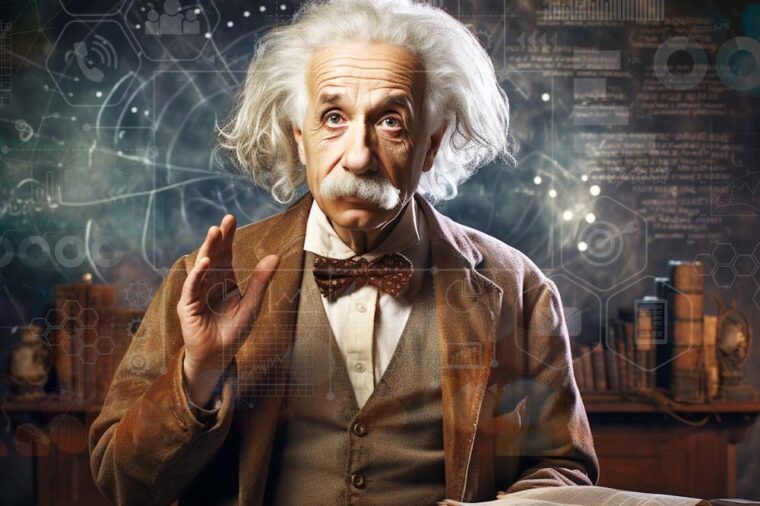
So, what's the difference between understanding and deeply understanding a problem? Simply put, understanding a problem means recognizing its existence and perhaps having a basic grasp of its nature. However, deeply understanding a problem involves knowing its root causes, implications, context, and repercussions. It's like the difference between knowing the surface of a lake and exploring its depths.
One noteworthy example of Einstein's approach to deep understanding is his development of the theory of relativity. Einstein didn't just stumble upon E=mc^2; he spent a decade wrestling with the problem. His deep understanding of the issue allowed him to question the established Newtonian physics. He explored every facet of the problem, considering the implications of a universe where the speed of light was constant and time was not absolute. This deep dive into understanding the fundamentals
led him to his groundbreaking theory that revolutionized our understanding of physics. It truly encapsulates Einstein's approach to problem-solving — spend more time understanding the problem, and the solution will follow.
Jumping To The Solution
“Every problem you encounter is merely an undiscovered opportunity dressed in disguise; decode it, and you unlock the door to your next innovation!”
By nature, humans are solution-oriented beings. We tend to leap into action, trying to fix things immediately, often skipping the crucial step of thoroughly comprehending the problem. This approach may work for simple issues, but for complex problems, it can lead to ineffective solutions, wasted resources, and frustration.
Research supports this inclination towards immediate problem-solving. Psychologists Heur and Oyserman's study, “Identity-based motivation and school success: when does ‘wanting to do well' lead to ‘doing well'?” demonstrates that students exposed to problems often revert to quick fixes instead of understanding the underlying concepts. Similarly, a research article by Kai Ruggeri and colleagues in Nature Human Behaviour showed that when dealing with policy issues, people largely favored immediate, tangible solutions over long-term strategies.
People also demonstrate examples in everyday life. Consider the common approach to addressing symptoms in healthcare. For instance, a patient with chronic headaches might be prescribed painkillers without investigating the underlying causes, such as stress or poor diet. This ‘band-aid' solution may provide temporary relief but fails to address the root cause, leading to recurring issues.
Why We Jump to Solutions: A Deeper Look
By bypassing a deep understanding of the problem, we may inadvertently overlook viable solutions, waste valuable resources, or even exacerbate the issue. To help you resist the urge, let us dive deeper and look at why we jump to solutions:
- Impatience : We live in a fast-paced, instant-gratification culture. We want things done quickly, and this includes solving problems. Deep understanding requires time and patience, which we are often unwilling to invest.
- Perceived Efficiency : We often mistake quick action for productivity. Taking a direct approach to solutions provides us with a sense of progress and efficiency, even though these feelings may be illusions if the solutions do not align with the real problem.
- Simplicity Bias : We tend to oversimplify complex problems. By jumping to solutions, we avoid the painful task of delving into the complexities and ambiguities of the problem.
- Emotional Discomfort : Deeply understanding a problem often means acknowledging uncomfortable truths. Avoiding these emotions by focusing on solutions, even if they are ineffective, is easier.
- Pressure to Perform : Particularly in professional contexts, there may be pressure to produce results fast. This can make us prioritize solution-generating over problem understanding.
- Overconfidence : Sometimes, we think we understand the problem better than we do. This overconfidence can lead us to premature solution development.
By recognizing these tendencies, we can check ourselves before rushing into solution mode, ensuring we devote sufficient time and resources to understanding the problem.
Benefits of Deeply Understanding The Problem
The merits of devoting time and effort towards thoroughly comprehending a problem extend far beyond the immediate. They ripple through the entire problem-solving process, fostering innovative thinking, enhancing decision-making, and ultimately leading to more effective and enduring solutions. So, let's delve into the specific benefits of deeply understanding a problem.
- Greater efficiency : When you fully understand a problem, you can tackle it more efficiently. You know where to focus your energy and resources, which reduces wasted effort and increases productivity.
- Improved decision-making : A deep understanding of a problem equips you with the information necessary to make informed decisions. It allows you to evaluate potential solutions more critically, ultimately selecting the most effective solution.
- Enhanced creativity : Deep understanding can spark creativity by revealing unexpected aspects of the problem. This can lead us to explore innovative solutions we might not have considered otherwise.
- Improved communication : When you understand a problem deeply, you can communicate it more effectively to others, enabling better collaboration and collective problem-solving.
- Reduced risk : Deep understanding reduces the risk of implementing a solution that could worsen the problem. By thoroughly understanding the problem, you can anticipate potential pitfalls and plan accordingly.
- Increased confidence : When you fully understand a problem, you gain confidence. This confidence can be instrumental in persuading others to support your proposed solution and persevere when challenges arise .
How To Truly Understand A Problem
Truly understanding a problem is a journey that requires deliberate, systematic steps. It means peeling back the layers of the issue, investigating its roots, and exploring its implications in depth. This process does not only reveal the problem's true nature but also illuminates its potential solutions. Incorporating various techniques and methods into this process can enhance our understanding of problems, leading to more effective and sustainable solutions. Let's delve into the steps involved in truly understanding a problem.
So, how can one truly understand a problem? Here are some steps:
- Identify the Problem : This might seem obvious, but it's crucial to be clear about the problem. Define it in clear, concise terms. A vague or poorly defined problem is difficult to understand and solve effectively.
- Gather Information : Collect as much relevant information about the problem as possible. This includes facts, figures, opinions, experiences, and other pertinent data. This information can help you understand the problem's depth and breadth.
- Analyze the Information : Once you have gathered the information, analyze it. Look for patterns, relationships, and anomalies. This analysis can provide insights into the underlying causes of the problem.
- Ask Why : Don't stop at the surface level. Keep asking ‘why' until you get to the root cause of the problem. The ‘5 Whys' technique, often used in problem-solving, involves asking ‘why' five times or as many times as needed to reach the root cause.
- Consider the Context : Understand the context in which the problem exists. Consider the social, economic, political, and environmental factors influencing the problem.
- Think About the Consequences : Consider the potential consequences if the problem is not solved. This can provide further insights into the importance and urgency of the problem.
- Reflect and Absorb : After gathering and analyzing the information, take some time for reflection. Allow your subconscious mind to absorb the information and generate insights.
- Consult Others : Don't try to understand the problem in isolation. Consult others who offer different perspectives or have experience dealing with similar problems. Their insights can enhance your understanding of the problem.
- Challenge Your Assumptions : Be critical of your assumptions and biases. They can cloud your understanding of the problem.
- Stay Open-Minded : Keep an open mind throughout the process. Your understanding may shift and evolve as you learn more about the problem.
Problems vs. Opportunities
“Innovation thrives not when we rush to solutions but when we dare to dwell in the depths of problems.”
Problems and opportunities can often seem opposites but are intrinsically linked. Frequently, seizing an opportunity is all a problem needs. Understanding problems and opportunities has many parallels, and our techniques to dissect problems can also enhance our understanding of opportunities.
We typically view problems as hurdles that impede our progress. They are challenges that need solutions. Conversely, opportunities are favorable circumstances that can lead to positive outcomes if capitalized upon. But the line separating the two can often blur. A problem can unveil an opportunity to innovate or improve, and an opportunity can uncover dormant issues that necessitate careful scrutiny .
We can apply the principles we use to understand problems and comprehend opportunities. We can gain a deeper understanding of both by asking similar questions, considering the same factors, and taking a systematic approach.
Einstein's quote is a reminder that problem-solving is not just about solutions; it's about understanding. By deeply understanding the problem first, we equip ourselves with the knowledge and insight necessary to find the best solution. So, the next time you face a problem, remember to dive deep before you swim towards the solution. You'll be surprised by how quickly and efficiently you reach your destination.
To learn more about Einstein's secret to problem-solving, listen to this week's show: Einstein's Secret to Effective Problem-Solving: Deep Understanding of the Problem .
Podcast: Download | Embed
Subscribe: RSS

Please note: I reserve the right to delete comments that are offensive or off-topic.
Leave a Reply Cancel reply
Your email address will not be published. Required fields are marked *
Save my name, email, and website in this browser for the next time I comment.
This site uses Akismet to reduce spam. Learn how your comment data is processed .
Privacy Overview
- Quote of the Day
- Picture Quotes
Albert Einstein Quotes
Standart top banner.
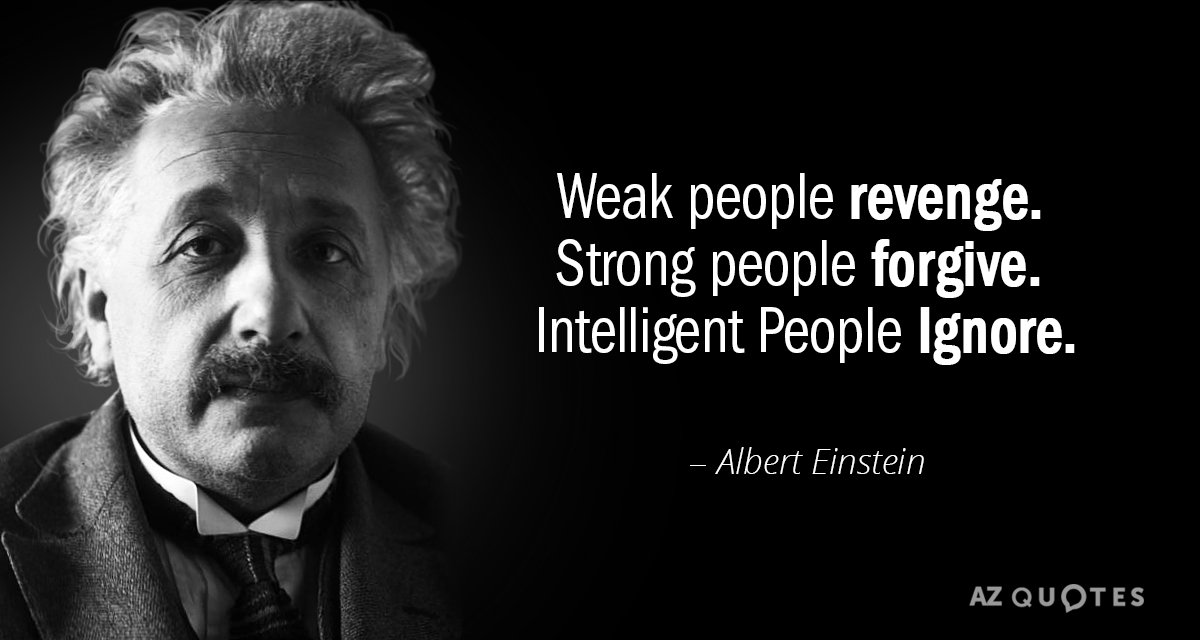
Weak people revenge. Strong people forgive. Intelligent People Ignore.
We are slowed down sound and light waves, a walking bundle of frequencies tuned into the cosmos. We are souls dressed up in sacred biochemical garments and our bodies are the instruments through which our souls play their music.
The difference between stupidity and genius is that genius has its limits.
We can't solve today's problems with the mentality that created them.
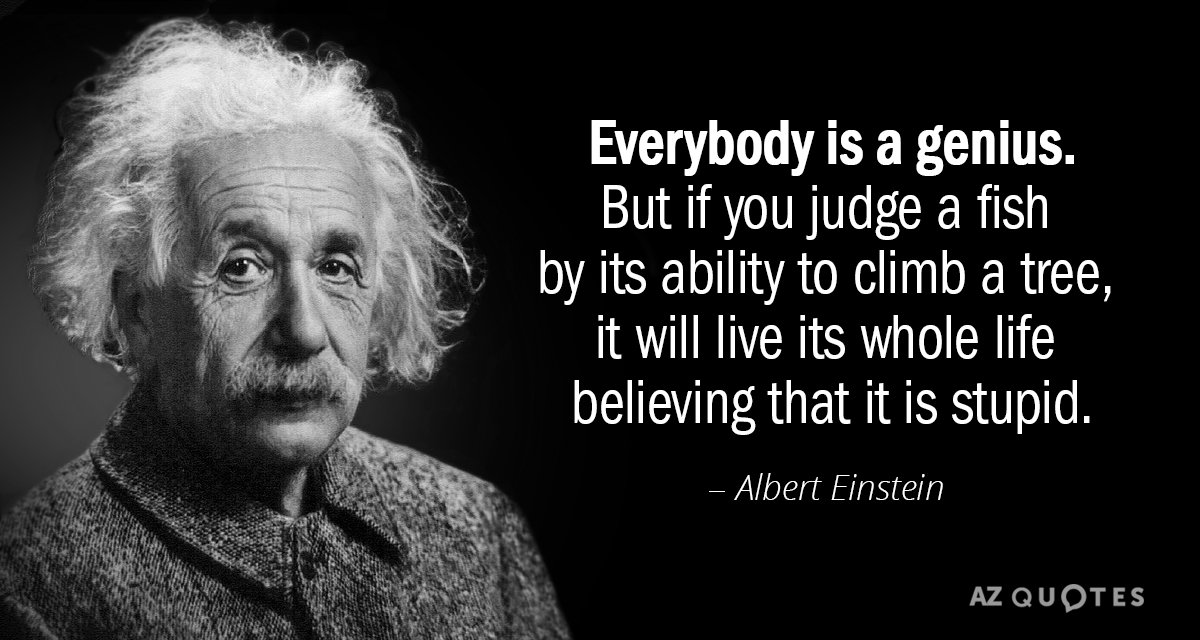
Everybody is a genius. But if you judge a fish by its ability to climb a tree, it will live its whole life believing that it is stupid.
The world will not be destroyed by those who do evil, but by those who watch them without doing anything.
Information is not knowledge. The only source of knowledge is experience. You need experience to gain wisdom.
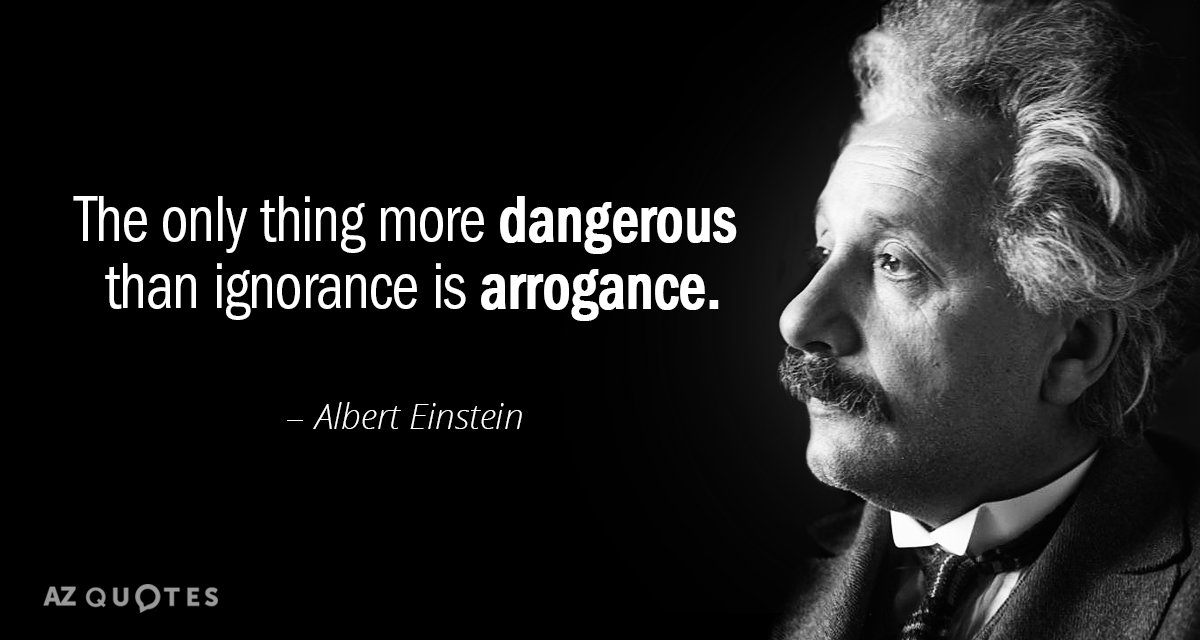
The only thing more dangerous than ignorance is arrogance
Failure is success in progress
Don't listen to the person who has the answers; listen to the person who has the questions.
The more I study science, the more I believe in God.
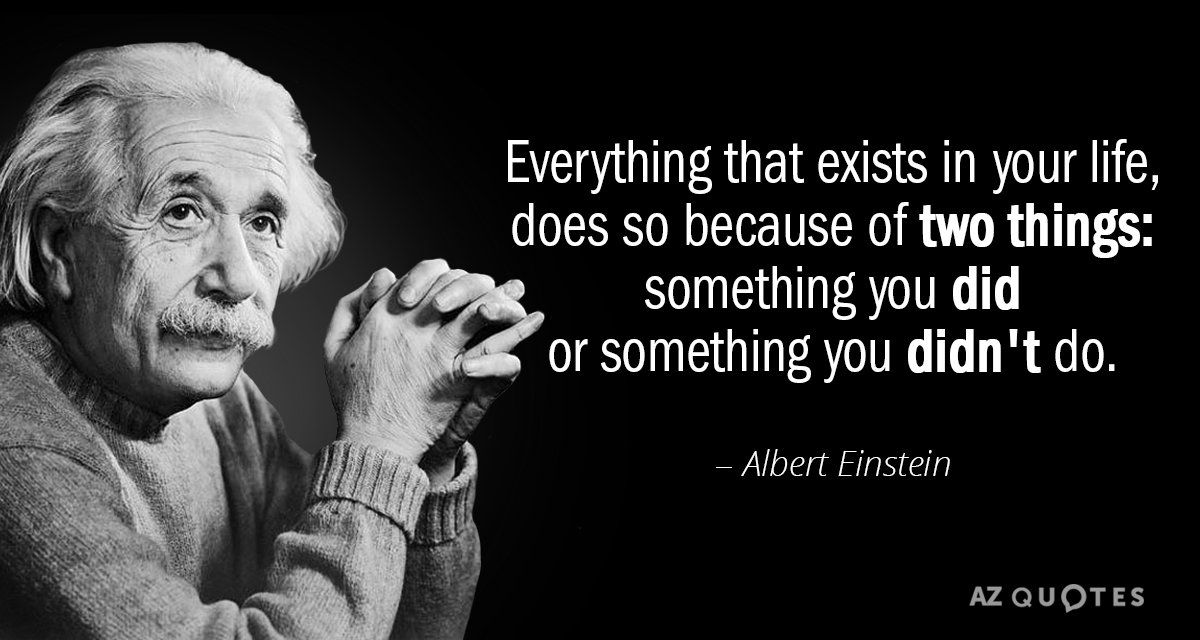
Everything that exists in your life, does so because of two things: something you did or something you didn't do.
Insanity: doing the same thing over and over again and expecting different results.
If you can't explain it simply, you don't understand it well enough.
Thinking is hard work; that's why so few do it.
Do not grow old, no matter how long you live. Never cease to stand like curious children before the Great Mystery into which we were born.
Persistence is the most powerful force on earth, it can move mountains.
artificial intellegance is no match for natural stupidity
Just because you believe in something does not mean that it is true.
I think 99 times and find nothing. I stop thinking, swim in the silence, and the truth comes to me.
Logic can take you from point A to point B. Imagination can take you wherever you want
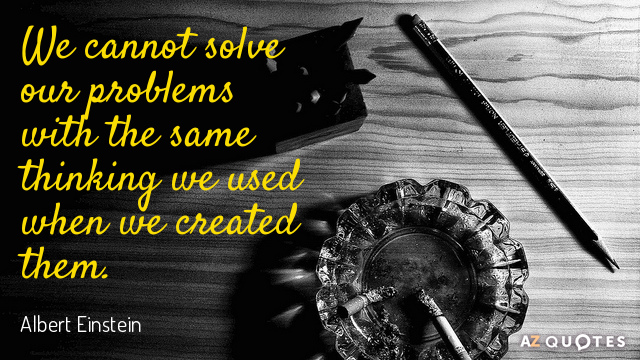
We cannot solve our problems with the same thinking we used when we created them.
I don't need to know everything, I just need to know where to find it, when I need it
Earth is the insane asylum of the universe.
God did not create evil. Just as darkness is the absence of light, evil is the absence of God.
last adds STANDART BOTTOM BANNER
Send report.
- The author didn't say that
- There is a mistake in the text of this quote
- The quote belongs to another author
- Other error

Latest quotes from interviews
"I am a determinist. As such, I do not believe in free will...Practically, I am, nevertheless, compelled to act as if freedom of the will existed. If I wish to live in a civilized community, I must act as if man is a responsible being."
Related Authors

Albert Einstein
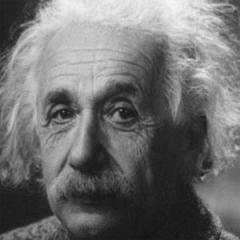
- Born: March 14, 1879
- Died: April 18, 1955
- Occupation: Theoretical Physicist
- Cite this Page: Citation
Get Social with AzQuotes
Follow AzQuotes on Facebook, Twitter and Google+. Every day we present the best quotes! Improve yourself, find your inspiration, share with friends
Popular Topics
- Inspirational
- Motivational
SIDE STANDART BANNER
- Quotes about:
- New Quotes (2)
- Achievement
- Agnosticism
- Animal Cruelty
- Animal Rights
- Appreciation
- Art And Science
- Atomic Bomb
- Being Alone
- Being Human
- Being Yourself
- Climate Change
- Common Sense
- Communication
- Competition
- Consciousness
- Conservation
- Constitution
- Contemplation
- Creative Thinking
- Daydreaming
- Determination
- Determinism
- Disappointment
- Encouraging
- Enlightenment
- Entrepreneurship
- Environment
- Fairy Tales
- Falling In Love
- Fear Of Death
- Freedom And Liberty
- Giving Back
- Helping Others
- Human Nature
- Human Rights
- Imagination
- Independence
- Individuality
- Inspiration
- Intelligence
- Jesus Christ
- Justification
- Knowing God
- Law And Order
- Libertarianism
- Life And Death
- Life And Love
- Making Mistakes
- Manifestation
- Mathematics
- Military Service
- Mindfulness
- Moving Forward
- Nationalism
- Natural Law
- Never Giving Up
- Not Giving Up
- Nuclear Energy
- Nuclear Power
- Nuclear Weapons
- Opportunity
- Peace Of Mind
- Perseverance
- Persistence
- Personality
- Politicians
- Positive Thinking
- Preparation
- Problem Solving
- Purpose Of Life
- Quantum Mechanics
- Quantum Physics
- Questioning
- Rationality
- Recognition
- Relationships
- Responsibility
- Science And Religion
- Science And Technology
- Self Esteem
- Selfishness
- Simple Life
- Social Justice
- Speculation
- Spirituality
- Stay Strong
- Success And Failure
- Time And Space
- Time Travel
- Understanding
- Visualization
- War Of The Worlds
- Javascript and RSS feeds
- WordPress plugin
- ES Version AZQuotes.ES
- Submit Quotes
- Privacy Policy
Login with your account
Create account, find your account.
Einstein's Problem Solving Skills: 5 Ways to Think
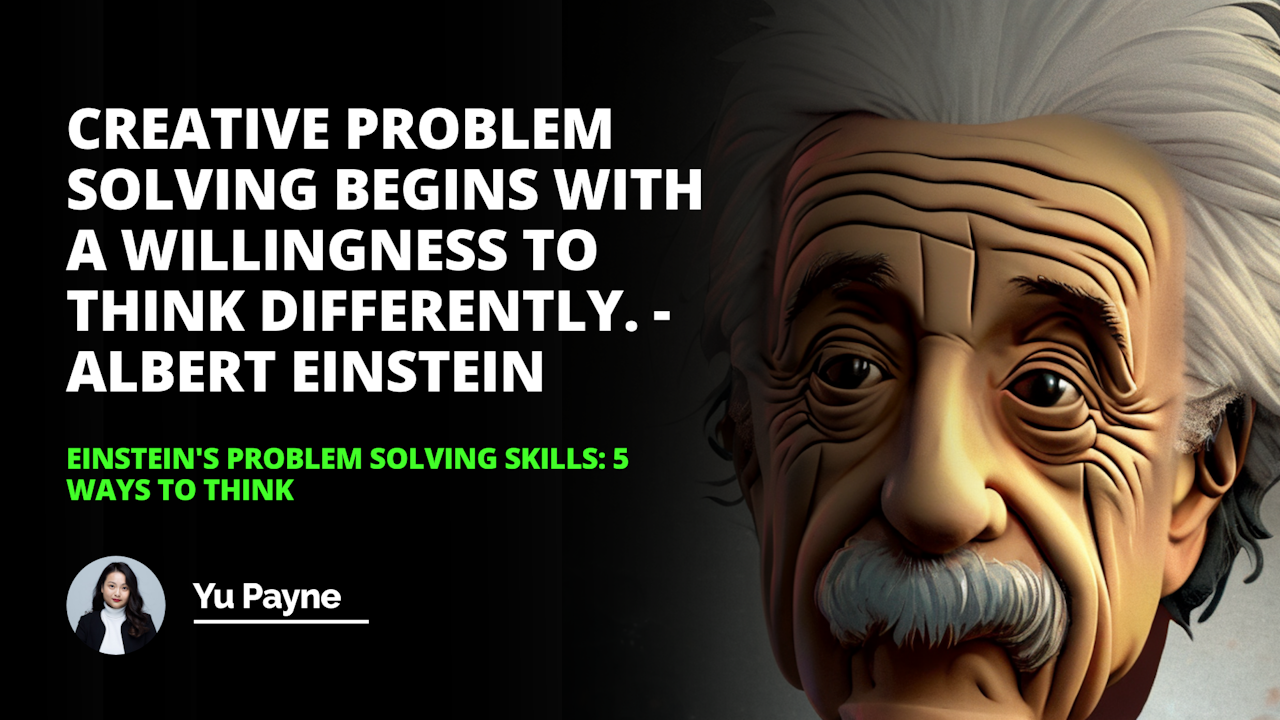
Albert Einstein was an iconic figure whose legacy remains to this day. This article explores five key ways Einstein thought, as revealed in three biographies of his life: visualization, combinatory play, intuition, imagination, and Gedanken experiments. These strategies allowed Einstein to make connections between seemingly unrelated ideas and explore the implications of his theories without the need for physical experiments or data. Einstein made groundbreaking discoveries through these strategies and shaped how we think about the world and the universe.
Introduction
Three biographies of Einstein
Five ways he thought
Visualization
Conjuring up a “picture” of the phenomena
Albert Einstein is one of the most iconic figures in history, and his legacy remains. His revolutionary theories and discoveries have shaped how we think about the world and the universe. While much has been written about Einstein's life and work, many aspects of his thinking remain a mystery. This article will explore five key ways Einstein thought, as revealed in three biographies of his life.
Visualization was one of the essential aspects of Einstein's thinking process.
He worked hard to conjure up a “picture” of the phenomenon he was investigating and waited for the image to reveal itself through action and interaction. This allowed him to gain a deeper understanding of the problem and make connections that he may not have been able to make otherwise.
The combinatory play was another essential way that Einstein thought. This involved bringing disparate pieces together in unpredictable combinations and exploring the outcomes. This allowed him to connect seemingly unrelated ideas and make unexpected discoveries.
Intuition was also an essential part of Einstein's thinking process. He believed in allowing his intuition free rein and accepting the results without explaining or questioning them. This allowed him to make leaps of logic that were not based on facts or data but on his internal understanding of the problem.
Imagination was also crucial to Einstein's thinking process. He believed that imagination was more important than knowledge and the key to unlocking new ideas and insights. He encouraged himself to open the gates to new thoughts and explore their possibilities of them.
Finally, Einstein relied heavily on Gedanken experiments. These experiments allow him to imagine a situation and explore the potential outcomes. This allowed him to explore the implications of his theories without the need for physical experiments or data.
SWOT Analysis Matrix: Comprehensive Guide to Strategic Decision Making
Quality Tools: Essential Techniques for Effective Decision-Making
Jidoka (Autonomation): Introducing Efficiency in Modern Industries
Probability and Impact Matrix: Insightful Guide to Risk Evaluation
In conclusion, the five key ways in which Einstein thought are visualization, combinatory play, intuition, imagination, and Gedanken experiments. These strategies allowed him to connect seemingly unrelated ideas and explore the implications of his theories without the need for physical experiments or data. By utilizing these five strategies, Einstein made groundbreaking discoveries and shaped the way we think about the world and the universe.
Creative problem-solving begins with a willingness to think differently. -Albert Einstein IIENSTITU
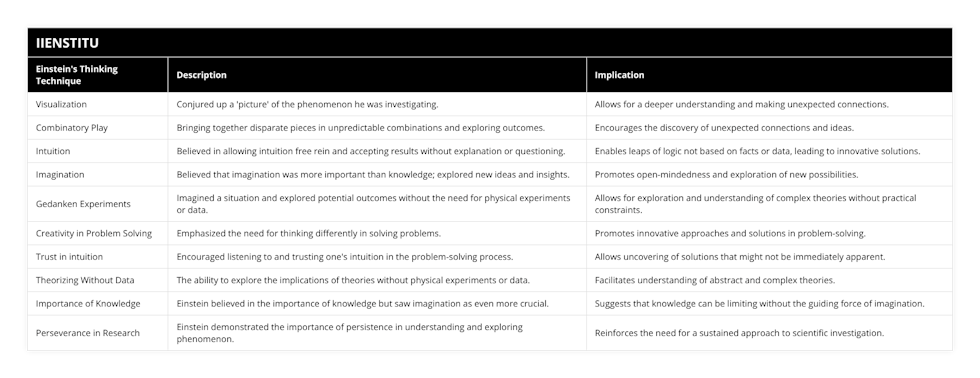

What are the five ways Einstein used to think?
Albert Einstein, one of the most renowned physicists of all time, has been credited with numerous scientific breakthroughs, such as the Theory of Relativity. His numerous contributions to science have been documented in various books and articles. However, the methods behind his success remain a mystery. This article will discuss five of how Einstein thought, known as the "Einstein Method."
The first step in the Einstein Method is to think broadly. He was known to be a master of connecting seemingly unrelated concepts and topics, allowing him to make discoveries that otherwise would have been overlooked. He could also transform seemingly mundane ideas into something truly revolutionary.
The second step of the Einstein Method is to question everything. Einstein was a deep thinker and was not afraid to ask difficult questions, even if he didn't have the answers. He could take seemingly simple ideas and ask "why" until he deeply understood the underlying concepts.
The third step of the Einstein Method is to remain persistent and patient. Einstein was willing to take the time to carefully consider and analyze a problem, even if it took him months or years. He was also ready to make mistakes to learn and was not afraid to start from scratch if he was unsatisfied with the results.
The fourth step of the Einstein Method is to think outside the box. He was known to be a master of lateral thinking and was unafraid to consider unconventional theories or ideas. He was also willing to challenge conventional wisdom and accepted views if he believed something more was to be discovered.
The fifth and final step of the Einstein Method is to think deeply. Einstein was known for his ability to go beyond the surface level of a problem and explore the underlying concepts. He was willing to challenge the status quo and look for new solutions to old problems.
In conclusion, Albert Einstein's genius resulted from his ability to think in five distinct ways. He could think broadly, question everything, remain persistent and patient, think outside the box, and think deeply. These five steps of the Einstein Method have been proven time and time again to be highly effective in solving complex problems.
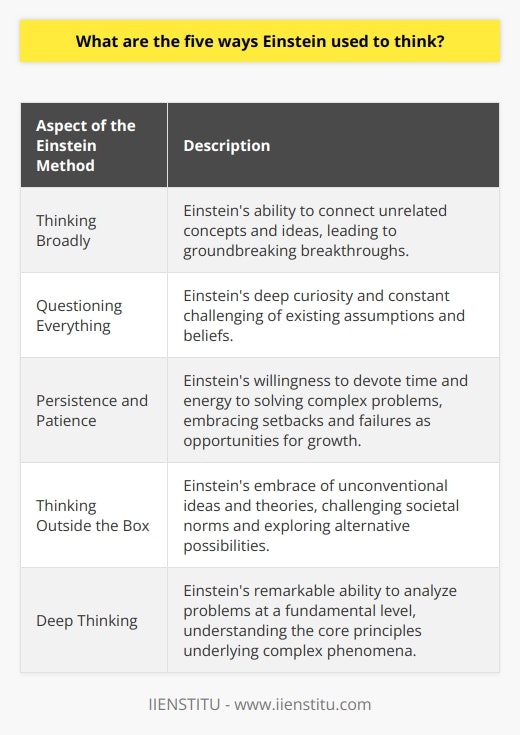
How did Einstein use visualization to solve problems?
Albert Einstein is widely regarded as one of the most brilliant minds of the twentieth century. His theories of relativity and quantum mechanics have been studied and expanded upon by scientists for decades. However, Einstein was not only a brilliant scientist but also an inventor and a master of visualization. He was able to use visualization to help him solve complex problems.
Visualization is a process in which one imagines a problem and visualizes the solution in their head. This allows a person to understand a problem's underlying principles better and come up with creative solutions. Einstein was a master of this technique, which is widely believed to be one of the critical factors that allowed him to develop his revolutionary theories.
One example of how Einstein used visualization to solve a problem can be seen in his work on the theory of special relativity. Einstein applied visualization principles to understand the approach by imagining himself riding on a light beam. This allowed him to conceptualize the idea of time dilation, a critical concept of special relativity.
Einstein also used visualization to help him understand the concept of space-time. To do this, he imagined a four-dimensional world in which time and space were intertwined. This allowed him to visualize the curved nature of space-time and the effects of gravity on it. This visualization permitted Einstein to understand and develop the general theory of relativity.
Einstein also utilized the power of visualization in his work on quantum mechanics. For example, he used visualization to help him understand the wave-particle duality of light and the uncertainty principle. By visualizing these concepts, Einstein was able to gain a better understanding of these complex principles.
Einstein's mastery of visualization was one of the critical factors that allowed him to develop revolutionary theories. His ability to imagine and visualize solutions to complex problems enabled him to see beyond the boundaries of traditional scientific thinking. This is one of the key reasons why he is regarded as one of the greatest scientific minds of all time.
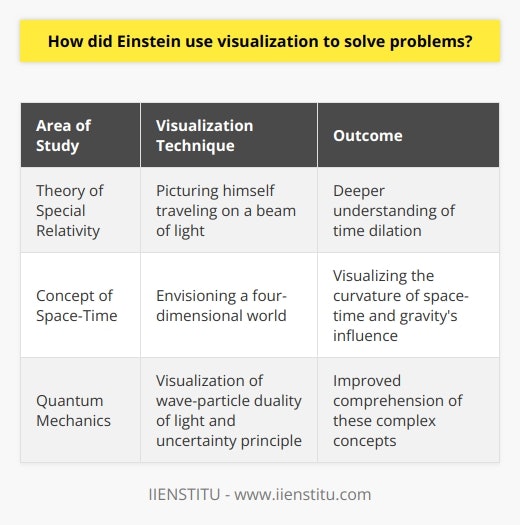
How did Einstein use intuition and imagination to solve problems?
Albert Einstein was one of the most renowned scientists of the 20th century and was famous for his use of intuition and imagination to solve problems. He believed the ability to think imaginatively and intuitively was essential to scientific exploration. He used his intuition and creativity to develop innovative ideas and theories.
Einstein attributed his successes to his creative imagination and intuition. He believed creativity and intuition could be used to develop new theories and solve complex problems. He argued that intuition was an invaluable aid in developing scientific theories, as it allowed him to think outside the box and create ideas that were not constrained by traditional methods of inquiry.
Einstein used his intuition and imagination to develop his Theory of Relativity. First, he observed the motion of light and used his intuition and creativity to formulate an equation describing light's behavior. He then used his intuition to develop a mathematical model to explain light behavior. Einstein's Theory of Relativity revolutionized physics and is still used to describe the universe's behavior today.
Einstein also used his intuition and imagination to develop his Unified Field Theory. First, he used his intuition to identify the fundamental forces that govern the universe. He then used his vision to create a mathematical model that would describe the behavior of these forces.
Einstein's use of intuition and imagination to solve problems was instrumental in his success as a scientist. He believed that intuition and imagination were essential tools for scientific exploration. He used his intuition and imagination to develop new theories and solve complex problems. His use of intuition and imagination to solve problems revolutionized physics and remains an essential tool for scientific exploration today.
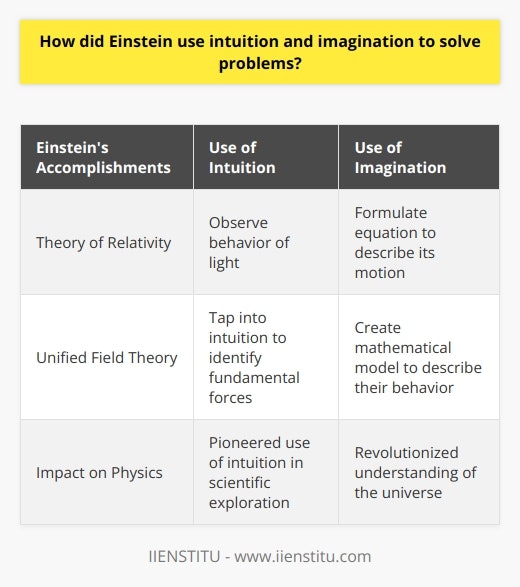
What are the five strategies of problem-solving in the context of academic research?
Akademik Araştırmada Problem Çözme Stratejileri 1. Problemi Tanımlama Akademik araştırmada problem çözmenin ilk adımı, problemin ne olduğunu açık ve kesin bir şekilde tanımlamaktır. Bu, araştırmanın temel sorusunu ve amacını belirleyerek başlar ve ardından sorunun nedenleri ve etkileri üzerinde odaklanmayı gerektirir. 2. Bilgi Toplama Problem çözmeye yönelik bir diğer strateji, sorunun anlaşılması ve çözülmesi için gereken bilgileri toplamaktır. Bu süreç, mevcut literatürü incelemeyi, daha önce yapılmış çalışmalardan ve uzman görüşlerinden yararlanmayı içerir. 3. Alternatif Çözüm Yolları Geliştirme Bir sonraki adım, problemi çözmek için farklı çözüm yollarını düşünmek ve değerlendirmektir. Bu, farklı yaklaşımları ve metodolojileri kullanarak, soruna birden fazla açıdan yaklaşmayı ve uygun çözümleri belirlemeyi içerir. 4. Çözümün Uygulanması Araştırmada problem çözmenin dördüncü stratejisi, seçilen çözüm yolu üzerinde çalışmaya başlamaktır. Bu süreç, gerekli verileri toplamayı, analiz etmeyi ve sonuçları yorumlamayı içerir. 5. Değerlendirme ve Revizyon Son olarak, problem çözme süreci içinde değerlendirmeyi ve revizyonu da içerir. Bu aşamada, çözümün etkili ve uygun olduğuna dair kanıtlar toplanarak, daha ileri araştırma veya uygulama için herhangi bir değişiklik yapılması gerekip gerekmediğini belirlemek önemlidir. Sonuç olarak, akademik araştırmada problem çözme stratejileri, problemin doğru bir şekilde tanımlanması, bilgi toplanması, alternatif çözüm yollarının geliştirilmesi, çözümün uygulanması ve sonuçların değerlendirilmesi ve gerektiğinde revize edilmesine dayanmaktadır. Bu stratejiler, araştırmacılara, problemleri etkili bir şekilde ele almak ve çözmek için gereken araçları sağlar.
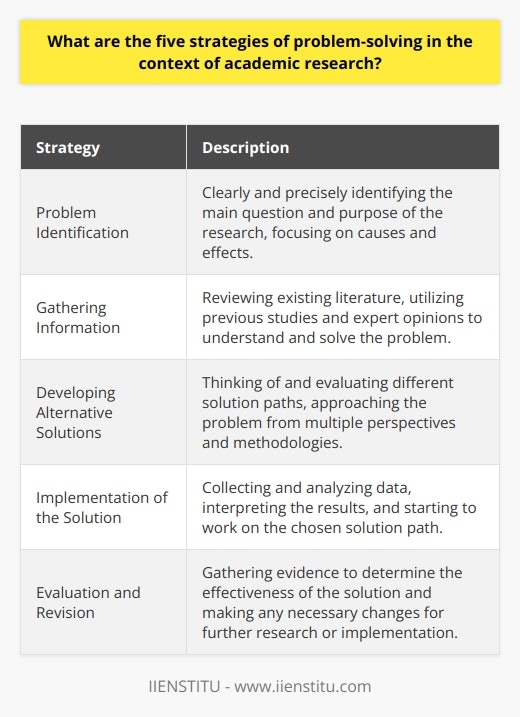
In relation to Einstein's approach to problem-solving, can you explain his perspective on thinking differently to tackle complex issues?
Einstein'ın Problem Çözme Yaklaşımı Albert Einstein tarafından sıklıkla dile getirilen farklı düşünme anlayışı, problem çözmeye etkileyici ve yenilikçi bir yaklaşım sunar. Einstein, mevcut düşünce kalıplarını ve normları aşarak, karmaşık sorunlara çözüm getirebilecek yaratıcı ve özgün düşüncelere ulaşmanın önemini vurgular. Karmaşık Sorunlara Farklı Bakış Açısı Einstein, 'Bir sorunu yaratmak için kullanılan düşünce tarzını kullanarak çözüm bulamazsınız' şeklinde bir yaklaşım benimsemiştir. Bu, mevcut sorunları anlamak ve çözmek için farklı perspektiflerden, disiplinlerarası bilgi ve yöntemlerle yaklaşmak gerektiği anlamına gelir. Yaratıcılığın Rolü Einstein, yaratıcılığın bilim ve problem çözmedeki önemine inanıyor ve kendi başarılarında bu özelliğin büyük rolü olduğunu dile getiriyordu. Yaratıcılık ve hayal gücünün, bilimsel keşiflerin ve yeni fikirlerin birincil kaynağı olduğunu savunuyordu. Aşamalı Düşünme Metodu Einstein'ın problem çözme yöntemine göre, karmaşık sorunların üstesinden gelmek için aşamalı bir düşünme süreci benimsemek gereklidir. Farklı düşünme aşamaları, bilinmeyenlere odaklanmak ve problemi daha geniş ve bütünsel bir çerçevede görüp analiz etmeyi içerir. Deneyerek Öğrenme Einstein, bilgiyi deneyim yoluyla elde etme anlayışına sahipti. Yeni fikirler ve çözümler üretmek için yalnızca teorik bilgiden değil, öğrenmek ve yenilikleri deneyerek hedefe ulaşma sürecinin önemini vurguladı. Sonuç olarak, Einstein'ın problem çözme yaklaşımı, karmaşık konuları ele alırken farklı düşünme, yaratıcılık, aşamalı düşünme ve deneyimle öğrenme yöntemleri sayesinde başarılı sonuçlar elde etmeyi önerir. Bu yaklaşım, günümüz dünyasında bilgi patlaması ve değişen paradigmalarla birlikte düşünme ve problem çözme becerilerinin geliştirilmesinde hâlâ büyük öneme sahiptir.
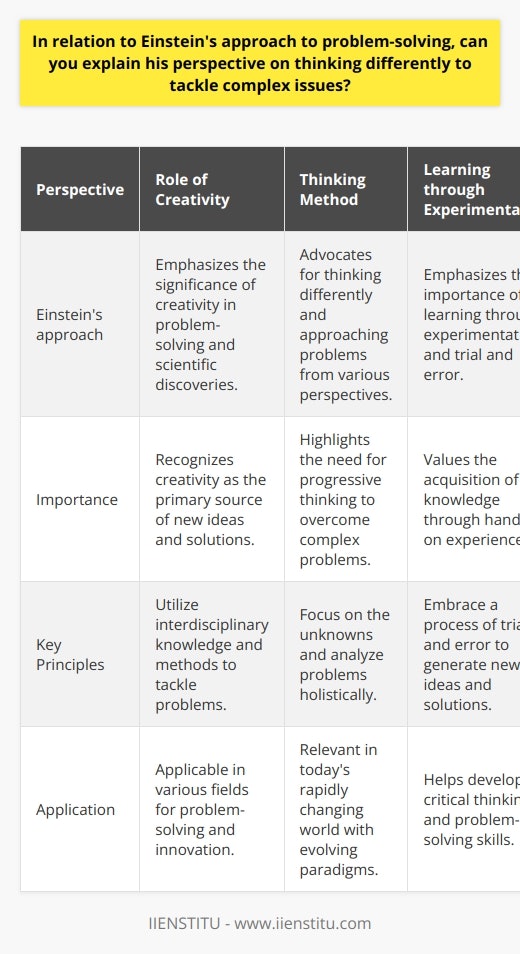
How does adopting a problem-solving mindset contribute to better understanding and resolving challenges in various academic disciplines?
Sorun Çözme Odaklı Zihniyetin Önemi Farklı akademik disiplinlerdeki zorlukları anlamak ve çözmek için sorun çözme odaklı bir zihniyet benimsemek, önemli ölçüde katkıda bulunur. Bu zihniyet, öğrencilerin bulundukları alanın karmaşıklığını ve değişkenlerini daha iyi kavramalarını sağlar. Analitik Düşünce Geliştirme Sorun çözme odaklı düşünce, analitik düşünme becerilerini geliştirir. Bu sayede, öğrenciler problemleri daha kapsamlı olarak değerlendirebilir ve her durum için en uygun stratejileri belirleyebilirler. Yaratıcı Yaklaşımların Teşvik Edilmesi Sorun çözmeye yönelik zihniyet, yaratıcılığı ve yenilikçi düşünceyi teşvik eder. Çeşitli akademik disiplinlerde yeni ve etkili yöntemlerin keşfi için yaratıcı yaklaşımların kullanılması önemlidir. Etkili İşbirliği ve İletişim Sorun çözme becerisinin benimsenmesi, etkili işbirliği ve iletişim ihtiyacını ortaya koyar. Farklı disiplinlerdeki zorlukların üstesinden gelmek için takım çalışması ve açık iletişim önem taşır. Esneklik ve Uyum Kabiliyeti Sorun çözme odaklı zihniyet, öğrencilere esneklik ve uyum yetisi kazandırır. Bu özellikler, farklı akademik disiplinlerde karşılaşılan zorluklarla baş etme becerisini artırır. Sonuç olarak, sorun çözme odaklı bir zihniyet benimsemek, çeşitli akademik disiplinlerde karşılaşılan zorlukların üstesinden gelmek için önemli bir adımdır. Bu zihniyet, analitik düşünce, yaratıcılık, işbirliği ve esneklik gibi becerilerin geliştirilmesine olanak tanır. Bu sayede, öğrenciler başarılı çalışmalar yürütebilir ve alanlarında öncü olabilirler.
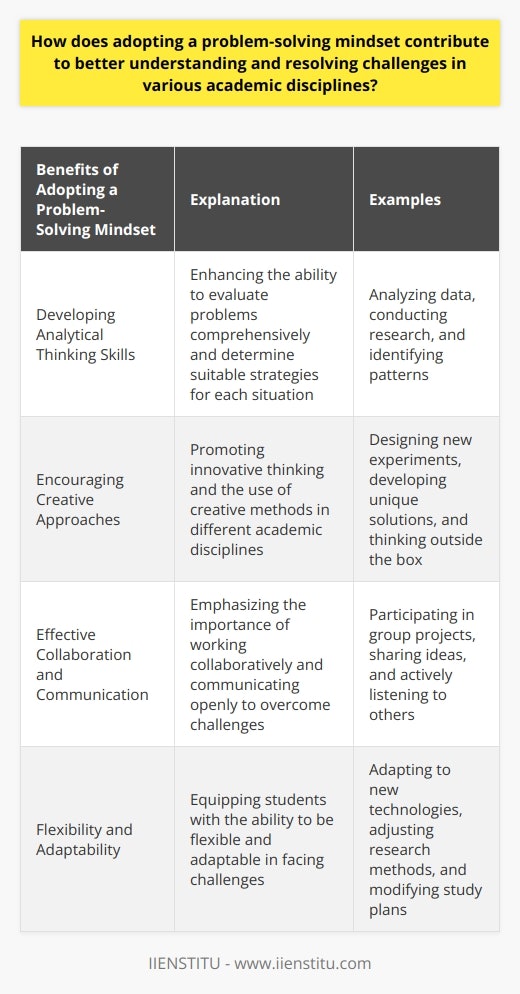
What are the key elements of Einstein's problem-solving philosophy, and how can they be applied in contemporary academic research?
**Einstein's Problem-Solving Philosophy** Einstein's problem-solving philosophy entails three crucial elements: a sense of curiosity, development of thought experiments, and engagement with the scientific community. The integration of these components in contemporary academic research can yield significant advancements and insights. **Curiosity-Driven Approach** Firstly, fostering a sense of curiosity is pivotal to Einstein's problem-solving approach. For Einstein, the desire to comprehend the natural world and unveil its underlying principles was a driving force behind his scientific inquiries. In the present academic landscape, embracing this spirit of curiosity encourages researchers to push boundaries, ask thought-provoking questions, and seek novel perspectives that enable breakthrough discoveries. **Thought Experiments** Secondly, Einstein emphasized the use of thought experiments, or Gedankenexperimente, to mentally simulate the implications of hypotheses and assumptions. This practice helps researchers to examine hypothetical scenarios, discern flaws in their underlying logic, and refine their approach accordingly. For example, imagine a researcher examining the impact of a stimulus on a group of individuals. By contemplating how different stimulus levels might exaggerate or negate the reaction, the researcher can craft a more robust experimental design. Thus, thought experiments provide a valuable tool for enhancing the soundness and intellectual merit of contemporary academic research. **Engagement with the Scientific Community** Lastly, Einstein's problem-solving philosophy highlights the importance of engaging with a diverse and intellectually rigorous scientific community. Einstein relied on the exchange of ideas, debate, and collaboration with other scientists to refine his theories and challenge prevailing paradigms. In the context of modern academic research, researchers can apply this principle by actively participating in conferences, workshops, and collaborative projects that stimulate cross-disciplinary discourse and foster innovative thinking. **Conclusion** In conclusion, Einstein's problem-solving philosophy - defined by curiosity, thought experiments, and engagement with the scientific community - can provide a robust foundation for optimizing contemporary academic research endeavors. By adopting these core components, researchers can stimulate innovation, refine their methodology, and facilitate advancements in the pursuit of knowledge.
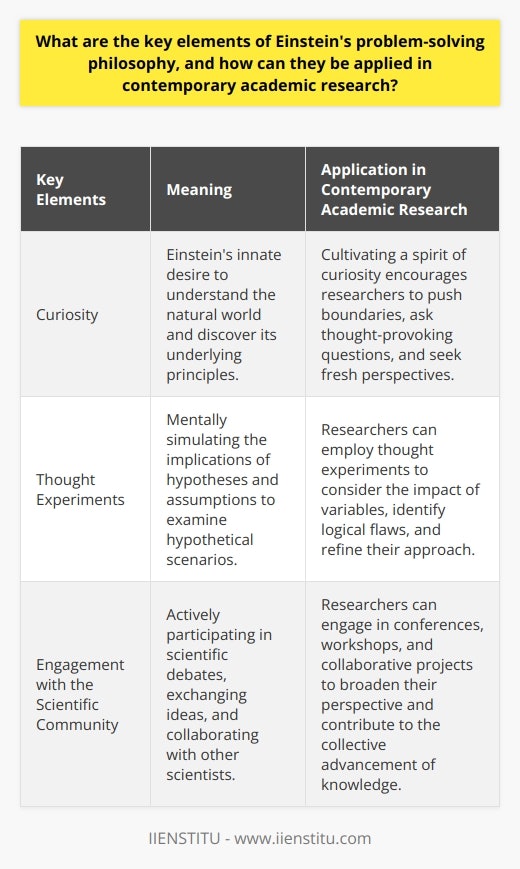
How does incorporating the problem-solving way of thinking, as exemplified by Einstein, enhance the process of addressing and navigating complex issues in various fields of study?
Embracing Einstein's Approach Incorporating the problem-solving perspective, which Einstein famously exemplified, offers significant benefits when addressing and navigating multifaceted issues spanning diverse fields of study. Einstein's method focuses on understanding the root of a problem, breaking it down into manageable components, and testing hypotheses through experimentation. Adopting this mindset enables individuals to better comprehend and manage intricate problems, leading to innovative and adaptable solutions. Critical Analysis of Issues A vital aspect of Einstein's approach lies in his reliance on critical analysis. He believed that the key to tackling difficult problems is to think deeply about the fundamental principles involved. By emphasizing such analysis, students and professionals alike can develop a solid conceptual foundation. This understanding allows for more effective communication, as individuals can address underlying key factors contributing to a situation or problem. Breaking Down Complexities Another element of Einstein's method involves breaking down complex problems into smaller, manageable parts. This technique encourages focusing on each subproblem individually, simplifying the task and promoting a sense of cognitive clarity. Consequently, abstract issues become increasingly tangible, which facilitates informed decision-making based on clear evidence, rather than relying on intuition or guesswork. Experimentation and Hypothesis Testing Einstein's commitment to experimentation and hypothesis testing is essential. These processes can provide tangible evidence to support or refute an idea, thereby strengthening the basis for decision-making. The ability to test ideas methodically ensures that solutions are both creative and empirically grounded. This approach also fosters a culture of continuous learning, as individuals can learn from errors or misconceptions to refine their understanding of complex issues. Applicability in Various Fields The versatility of the problem-solving approach makes it well-suited for application across diverse areas of study. From science and engineering to business and social sciences, the skills developed through Einstein's methods enhance practitioners' abilities to analyze and navigate intricate problems. This promotes innovative thinking, heightens adaptability, and ultimately leads to more sustainable and effective solutions. In conclusion, integrating Einstein's problem-solving way of thinking into various fields of study enriches the process of addressing and navigating complex issues. This approach emphasizes critical analysis, simplification of complexities, and experimentation, improving decision-making and fostering learning. By cultivating such skills, professionals and students can develop innovative, adaptable solutions to the multifaceted challenges that arise across disciplines.
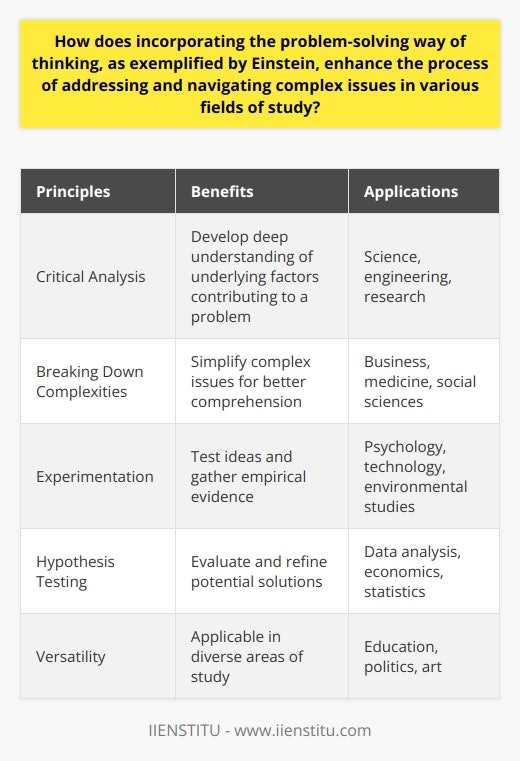
In light of Einstein's famous quote on problem-solving and thinking differently, what strategies can be employed to foster a more innovative and effective approach to tackling academic challenges?
**Einstein's Insight on Problem-Solving** Einstein's renowned quote, 'We cannot solve our problems with the same thinking we used when we created them,' suggests a strong need for adopting novel and innovative approaches to address academic challenges. A shift in mindset is crucial to overcoming obstacles and generating original solutions. **Encourage Creative Thinking** One strategy to cultivate innovation comprises fostering a learning environment that encourages creative thinking. By offering opportunities for brainstorming, active discussion, and open-minded questioning, educators can stimulate students to think differently and collaboratively, producing new insights and ideas. **Embrace Diverse Perspectives** Incorporating diverse perspectives is vital to cultivating an effective approach. By bringing together students from differing backgrounds, experiences, and cultures, inventive ideas can emerge. This fusion of viewpoints can spark fresh ideas and challenge established beliefs, promoting innovation. **Promote a Growth Mindset** Adopting a growth mindset is another essential strategy for tackling academic challenges. By emphasizing the importance of grit, perseverance, and flexibility, students become inspired to address problems from different angles, rather than giving up at the first sign of difficulty. With this mindset, failure is perceived as an opportunity for learning and growth, thereby fostering a generation of resilient, innovative problem-solvers. **Integrate Cross-disciplinary Approaches** Lastly, integrating cross-disciplinary approaches to problem-solving can result in more effective innovations. By combining techniques and knowledge from different fields, unexpected solutions may arise. The synthesis of ideas from various academic areas can provide an enriched perspective, fortifying a student's ability to tackle complex challenges. In conclusion, fostering innovation to tackle academic challenges must involve nurturing creative thinking, embracing diverse perspectives, adopting a growth mindset, and integrating cross-disciplinary approaches. By nurturing these qualities, we can instill a sense of curiosity, resilience, and adaptability in students, empowering them to approach challenges with fresh thinking, as Einstein advocated.
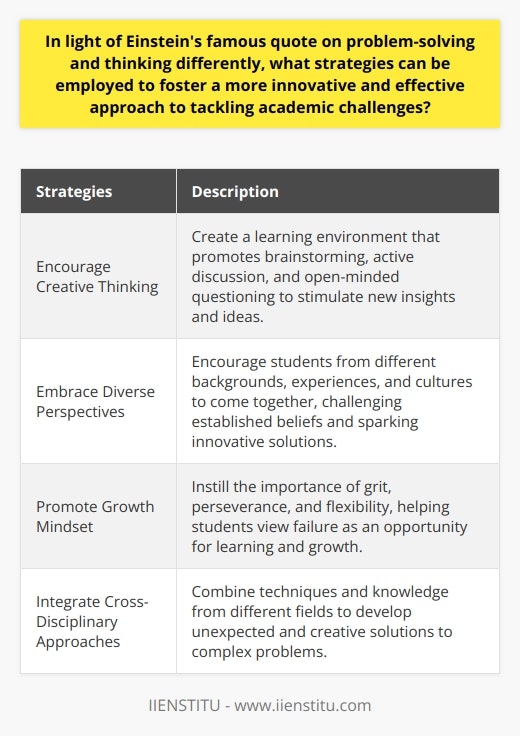
What are the primary characteristics of a problem-solving way of thinking, and how can this mindset be cultivated within academic fields?
Key Characteristics of Problem-Solving Thinking The primary characteristics of a problem-solving way of thinking include analytical skills, critical thinking, creativity, adaptability, and perseverance. These traits facilitate the identification and analysis of issues, the generation of innovative solutions, and the tenacious pursuit of success despite challenges. Developing Analytical Skills and Critical Thinking One crucial aspect of cultivating a problem-solving mindset is developing analytical skills and critical thinking. This includes evaluating information with a discerning eye, recognizing patterns and trends, and taking a systematic approach to solving problems. Students can improve these skills by engaging in debates, workshops, and discussions that require them to scrutinize complex and ambiguous concepts. Encouraging Creativity Another important element in fostering a problem-solving mindset is encouraging creativity. Students should be allowed to experiment with various strategies and ideas to find unique, innovative ways to address challenges. By providing a supportive environment where risk-taking and failures are accepted as valuable learning opportunities, educational institutions can help students build the confidence that enables successful problem-solving. Promoting Adaptability Problem-solvers must also possess adaptability, enabling the ability to acknowledge when an approach is ineffective and to revise strategies accordingly. Faculty can help nurture this skill by assigning projects that require flexibility and dynamism, such as interdisciplinary studies, group work, or assignments involving real-world situations that present unanticipated complications. Cultivating Perseverance Lastly, perseverance is a key ingredient to a problem-solving mindset. This trait motivates individuals to pursue resolutions to issues relentlessly despite setbacks and difficulties. Educators can instill this characteristic by providing a challenging academic environment where resilience is necessitated in overcoming obstacles. Integrating Problem-Solving into Academic Fields To successfully cultivate a problem-solving mindset within academic fields, educational institutions must incorporate these key characteristics into their curricula and teaching methodologies. By offering opportunities for the development of analytical skills, critical thinking, creativity, adaptability, and perseverance, academic institutions create well-rounded, capable problem-solvers that thrive in any context.
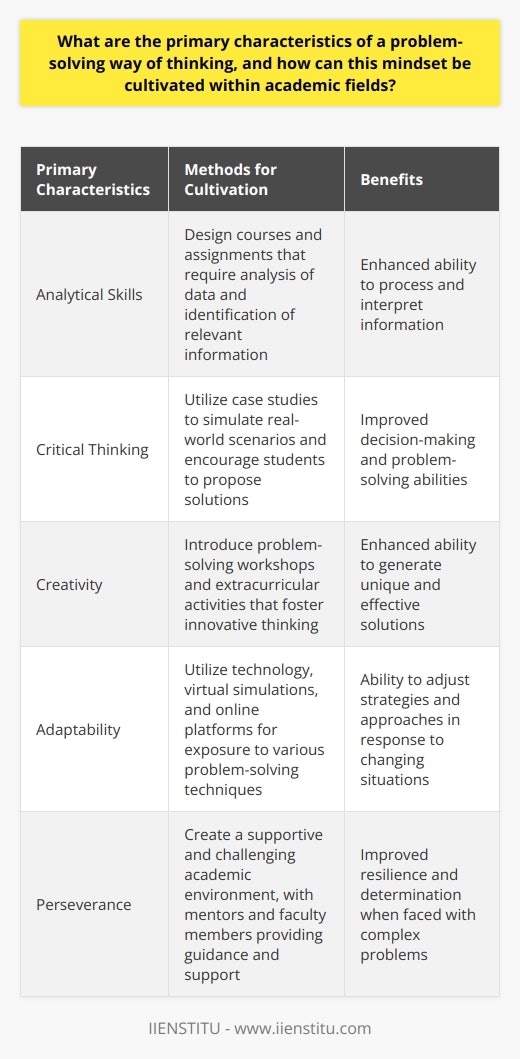
How does Einstein's perspective on problem-solving and the necessity of distinct thinking approaches contribute to our understanding of complex issues across various disciplines?
Einstein's Perspective on Problem-Solving Einstein's perspective on problem-solving involves approaching challenges with creativity and flexibility, emphasizing the importance of distinct thinking methods. This view is instrumental in helping us understand and navigate complex issues across diverse fields. Necessity of Distinct Thinking Approaches Einstein's perspective on problem-solving highlights the need for different thinking approaches to tackle complex issues, leading to better outcomes. By encouraging us to think beyond conventional wisdom, it contributes significantly to our ability to solve problems in various disciplines. Cross-Disciplinary Applications Einstein's ideas can be applied to multiple disciplines, giving them the flexibility to address complex issues by adopting innovative thinking processes. For example, in science, these principles can help us break through barriers, develop new technologies, and propel research forward. In the realm of economics, they can foster creative solutions to financial challenges or resource scarcity. Furthermore, in social science, they can lead to better understanding and resolution of societal conflicts. Promoting Critical Thinking Einstein's perspective on problem-solving promotes critical thinking and the development of analytical skills needed to grasp complex concepts. This emphasis on critical thinking is vital to mastering multidimensional issues faced in diverse fields. It inspires curiosity, fostering a spirit of inquiry and encouraging individuals to probe deeper into topics, leading to a more in-depth understanding of the subject matter. Encouraging Collaboration Using distinct thinking approaches also necessitates collaboration, as it encourages experts from different fields to work together towards solving complex problems. Einstein's perspective supports interdisciplinary collaboration, which combines insights from various subject areas, leading to more comprehensive solutions. In conclusion, Einstein's perspective on problem-solving and the need for distinct thinking approaches significantly contribute to our understanding of complex issues across various disciplines. By promoting flexibility, creativity, critical thinking, and collaboration, it creates space for us to develop innovative solutions to the challenges faced in today's rapidly evolving world.
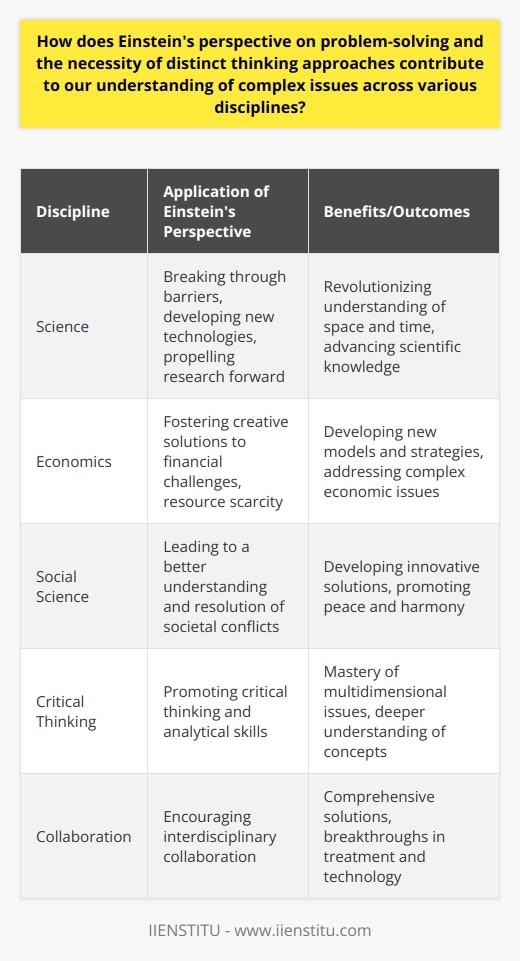
In the context of Einstein's problem-solving philosophies, how can researchers and academics create an environment conducive to fostering innovative solutions and novel approaches?
Embracing Curiosity and Open-mindedness In line with Einstein's problem-solving philosophies, researchers and academics can foster an environment conducive to innovative solutions by embracing curiosity and promoting open-mindedness. Einstein believed that curiosity driven investigations led to great achievements, stating that 'the important thing is not to stop questioning.' Therefore, cultivating an atmosphere where questions are encouraged, welcomed, and valued can empower individuals to challenge conventional wisdom and search for novel approaches. Adopting a Multidisciplinary Approach To foster innovation within academia's confines, it is essential to promote cross-disciplinary collaborations and non-linear thinking. Einstein's success in understanding the universe's complexities hinged on his ability to draw from various disciplines, merging physics, mathematics, and philosophy. By encouraging researchers to adopt a multidisciplinary approach, academics can higher the probability of transcending traditional boundaries and igniting the intellectual curiosity needed for groundbreaking discoveries. Creating a Supportive Community Developing a community that supports and nurtures creative thinking is crucial to cultivating innovative environments. Einstein famously said, 'Anyone who has never made a mistake has never tried anything new.' As such, researchers and academics must create spaces where individuals can take risks without fear of failure, knowing that their peers and mentors are behind them. Recognizing that failures can lead to valuable learning experiences, such environments can foster a growth mindset and resilience, truly enabling novel ideas to flourish. Prioritizing Diversity and Inclusivity Lastly, nurturing a culture of inclusivity and diversity is paramount to generating innovative solutions. As Einstein emphasized, 'we cannot solve our problems with the same thinking we used when we created them.' By embracing individuals from diverse backgrounds and perspectives, academia can overcome the limitations of insular thinking and access a rich array of ideas, contributing to the generation of pioneering concepts and approaches. In conclusion, fostering innovative solutions and novel approaches within academia aligned with Einstein's problem-solving philosophies involves encouraging curiosity, adopting multidisciplinary thinking, creating supportive communities, and prioritizing diversity and inclusivity. Through these principles, researchers and academics can create environments that spur groundbreaking discoveries, thus advancing human knowledge and understanding.
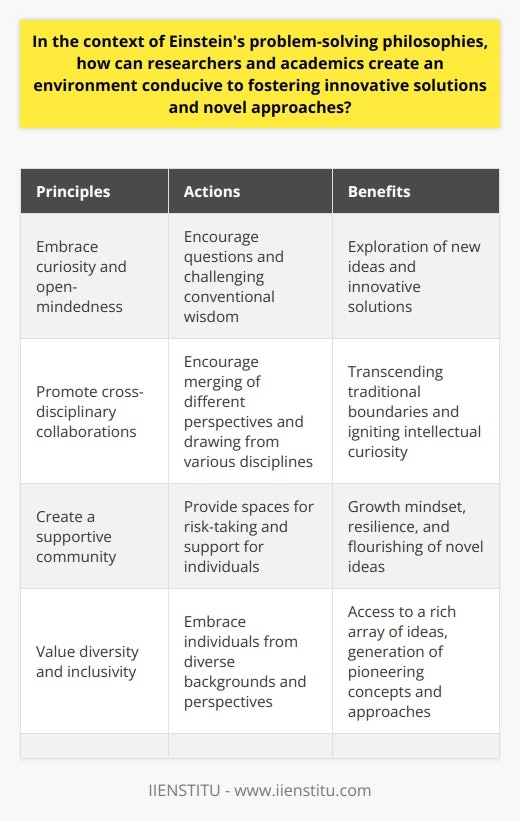
What are the core principles of a problem-solving way of thinking, and how can they be implemented in academic research methodologies?
Core Principles of Problem-Solving Thinking The core principles of a problem-solving way of thinking encompass understanding the problem, devising a plan, implementing the solution, and evaluating the results. Integrating these principles into academic research methodologies enhances the research process by promoting clarity, offering direction, and enabling researchers to ensure the validity of their findings. Understanding the Problem In academic research, understanding the problem involves clearly defining the research question or hypothesis, specifying the objectives, and identifying the desired outcomes. This step is crucial as it allows researchers to gain a comprehensive understanding of the issue at hand, enabling them to make well-informed decisions throughout the research process. Devising a Plan Devising a plan requires the researcher to outline a systematic approach to collecting and analyzing data. They must decide on the research design, select appropriate data collection methods, and establish the sampling technique. By creating a detailed and structured plan, researchers ensure that they are equipped to address the research question effectively. Implementing the Solution Carrying out the planned research activities is crucial for generating empirical evidence to support or refute the research hypothesis. This phase involves data collection, data analysis, and interpretation of results. Researchers must adhere to ethical guidelines and maintain objectivity, ensuring the validity and reliability of their findings. Evaluating the Results The final step in the problem-solving way of thinking is evaluating the results. Researchers must draw conclusions based on the findings, discuss the implications of the results, and consider limitations and potential areas for further inquiry. This process allows researchers to assess the impact of their work and identify possible improvements for future iterations of their research. Implementing Problem-Solving Thinking in Academic Research Incorporating problem-solving thinking into academic research methodologies bolsters the quality of research by providing a structured, systematic, and ethical approach to addressing complex issues. By fostering a deeper understanding of the problem, devising a solid plan, implementing the solution, and evaluating the results, researchers can cultivate a rigorous and robust research process.
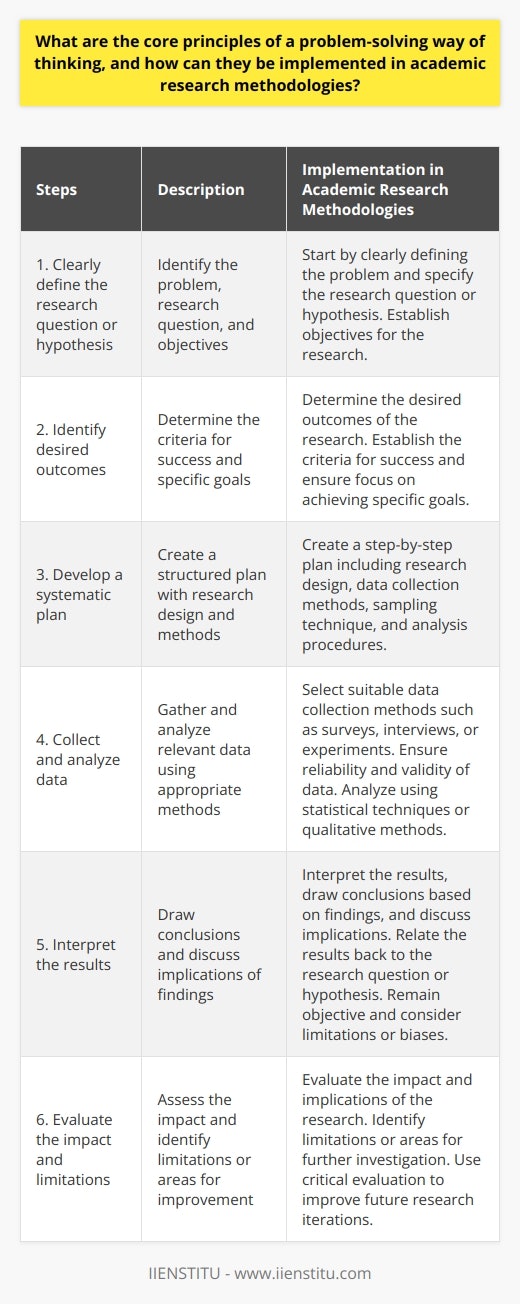
How did Einstein's perspective on problem-solving influence the development of his groundbreaking theories, and what insights can be gleaned for contemporary researchers?
Einstein's Problem-Solving Process Albert Einstein's innovative problem-solving approach played a pivotal role in shaping his groundbreaking theories, which subsequently transformed the landscape of modern physics. His exceptional methodology offers valuable insights for contemporary researchers, encouraging them to think beyond the conventional boundaries and embrace the power of imagination. Embracing Thought Experiments Remarkably, Einstein relied on thought experiments, where he envisioned hypothetical situations that helped him develop an intuitive understanding of abstract concepts. These mental explorations allowed him to refine his ideas before undertaking a mathematical formulation, as seen in his development of the General Theory of Relativity. Carrying out such thought experiments, contemporary researchers can stimulate creativity and gain new insights into complex issues. The Role of Intuition Einstein strongly believed in the power of intuition, which guided him in formulating and testing his theories. He once stated, 'There is no logical way to the discovery of the essential nature of the world. There is only the way of intuition.' This emphasis on intuitive thinking encourages contemporary researchers to trust their instincts and engage in hunch-driven exploration, which leads to groundbreaking discoveries. Overcoming Preconceived Notions A significant aspect of Einstein's problem-solving approach was his ability to question and dismantle pre-existing beliefs about the physical world. He challenged the long-held assumption that space and time were fixed entities, proposing the radical idea of space-time curvature in his General Theory of Relativity. Such tenacity in questioning established norms provides a valuable lesson for contemporary researchers to challenge the status quo and seek scientific advancement. Adopting an Interdisciplinary Approach Einstein's remarkable range of interests spanned across diverse fields, including philosophy, politics, and music. His exposure to different disciplines allowed him to synthesize ideas and view problems from multiple perspectives, contributing to his scientific breakthroughs. Contemporary researchers can benefit from adopting an interdisciplinary approach to problem-solving, fostering innovative thinking patterns and tapping into previously untapped sources of knowledge. In conclusion, Einstein's problem-solving approach embodies the essence of innovative thinking within the scientific realm. By embracing thought experiments, valuing intuition, questioning pre-existing beliefs, and fostering interdisciplinary thinking, contemporary researchers can make significant strides in their quest for knowledge and the development of novel theories.
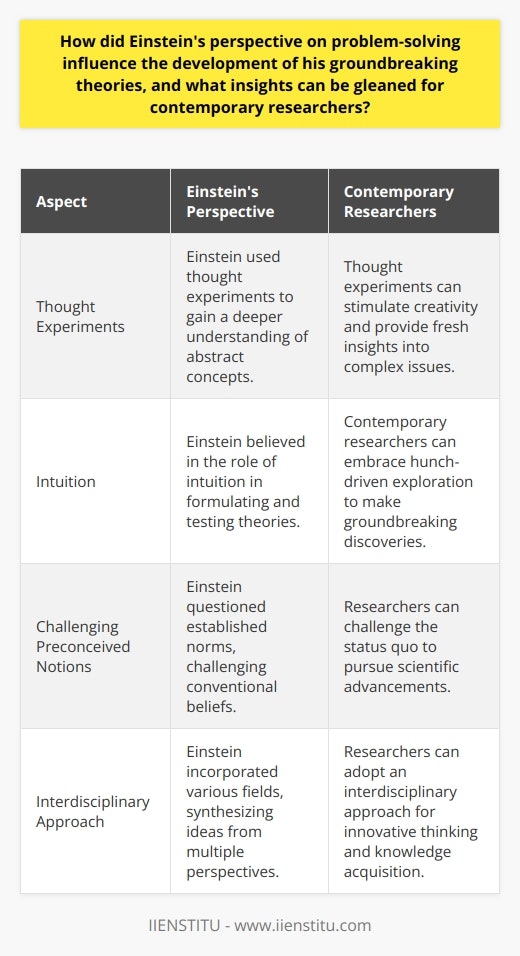
In the context of Einstein's belief that we cannot solve problems with the same thinking that created them, what are some strategies for cultivating a transformative mindset in academic research and problem-solving?
Redefining the Inquiry Process One crucial strategy for cultivating a transformative mindset in academic research and problem-solving is redefining the inquiry process. Researchers ought to employ intellectual curiosity and reflexivity in order to question pre-existing assumptions, design innovative research questions, and pursue alternative research methods. This allows scholars to critically evaluate their own work, as well as that of others, creating more effective and inclusive academic practices. Embracing Interdisciplinarity Another essential approach to fostering transformative thinking in academia is embracing interdisciplinarity. By actively seeking connections and collaborations across various disciplines, researchers gain a broader contextual understanding of their subject matter. Drawing on insights and methodologies from multiple fields exposes academics to diverse perspectives, fostering creative and innovative solutions to critical problems. Encouraging Divergent Thinking Promoting divergent thinking is an essential step for cultivating a transformative mindset. Divergent thinking involves considering multiple possibilities and solutions to complex issues simultaneously. Encouraging this approach in academic research and problem-solving fosters a willingness to take risks, tolerate ambiguity, and tolerate uncertainty. Developing these individual attributes is essential for approaching challenges with an open mind, embracing novel ideas, and transcending traditional thought paradigms. Contextualizing Knowledge Production To cultivate a transformative mindset, academics must recognize the need for contextualizing knowledge production. Acknowledging the social, political, and historical contexts within which research is conducted enables researchers to challenge dominant paradigms and open doors for alternative interpretations. Additionally, contextualizing knowledge production contributes to tackling global issues by foregrounding the role of diverse thinkers and their respective cultural contributions. Adopting an Experiential Learning Approach Lastly, adopting an experiential learning approach in academic research and problem-solving is crucial for fostering transformative mentalities. Experiential learning emphasizes direct, hands-on experiences and practical applications, allowing researchers to challenge their worldviews and foster personal growth. Implementing this strategy enables individuals to actively build, evaluate and modify their assumptions and beliefs, leading to transformative learning experiences. In conclusion, cultivating a transformative mindset in academic research and problem-solving requires multiple shifts in thinking and practice. By redefining the inquiry process, embracing interdisciplinarity, encouraging divergent thinking, contextualizing knowledge production, and adopting an experiential learning approach, researchers can transcend traditional thought patterns and create innovative solutions that align with Einstein's belief in thinking differently to solve complex problems.
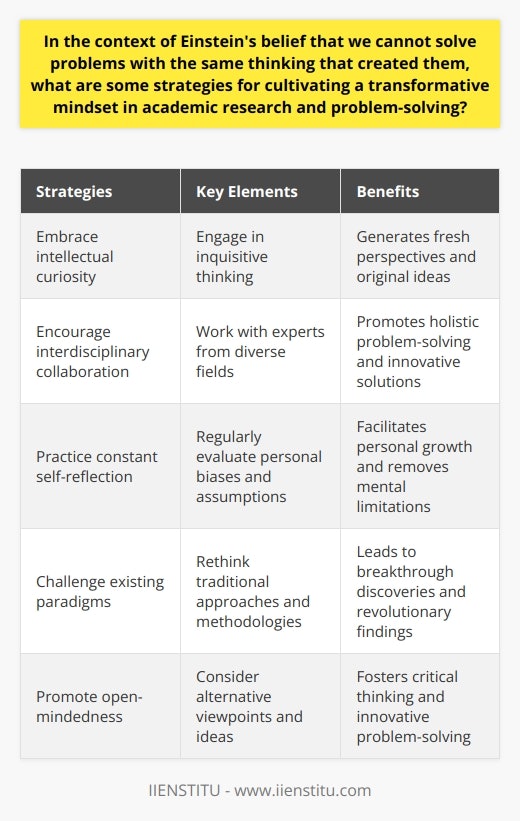
What are the five ways of developing problem-solving skills?
Developing Deep Understanding The development of problem-solving skills starts by having a deep understanding of a problem. This involves identifying the problem and considering its root causes. Use critical thinking skills to dissect complex problems. Consider assumptions, evaluate arguments, and understand logical connections between ideas. Practicing Diligence Secondly, practice diligence in addressing problems. Patience and perseverance play vital roles in problem-solving. The willingness to revise and refine your work significantly improves problem-solving skills. Effort could make the difference between successful conclusions and incomplete solutions. Adopting a Systematic Approach Thirdly, adopt a systematic approach when solving problems. Systems help to create order and structure. They support the meticulous examination of different solutions and their impacts. It is essential to explore all possible solutions while designing optimum outcomes. Incorporating Creative Thinking Fourthly, incorporate creative thinking into your problem-solving toolkit. Unconventional thinking opens the door to innovative solutions. It facilitates the brainstorming process, generating novel ideas and abstract concepts. Remember: thinking outside the box often uncovers optimal solutions. Learning from Mistakes Lastly, embrace mistakes as learning opportunities. Reflect upon failures and strive to understand what went wrong. This process enhances decision-making abilities, enriches knowledge, and builds resilience. Continuous learning remains vital for improving problem-solving skills. In closing, developing problem-solving skills involves deep understanding, practicing diligence, adopting a systematic approach, incorporating creative thinking, and learning from mistakes. These strategies foster resilience, innovation, and efficiency in problem-solving.
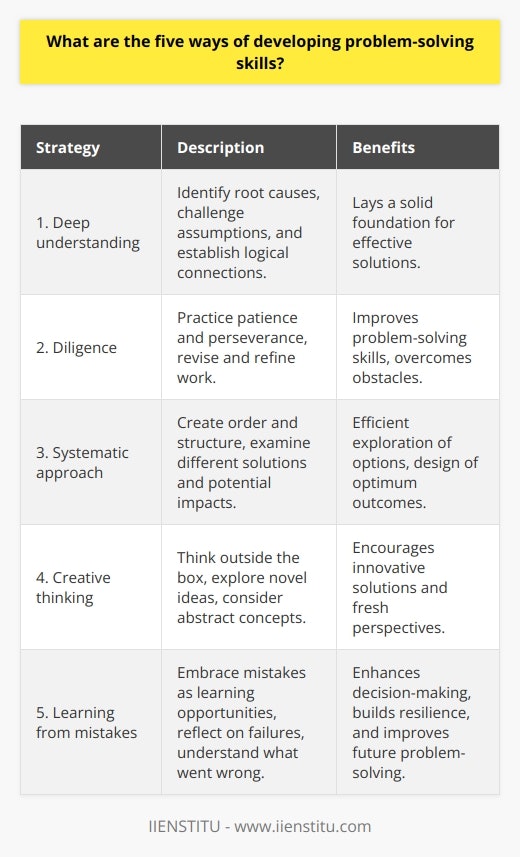
Did Einstein say we can't solve problems by using the same kind of thinking we used when we created them?
Interpreting Einstein's View A widely attributed quote to Einstein says that we cannot solve problems by using the same kind of thinking we used when we created them. However, despite its popularity, no documented evidence exists that the scientist actually verbalized or wrote this statement. Examining Its Authenticity While numerous online platforms and motivational speakers commonly attribute this quote to Einstein, no primary sources corroborate its authenticity. Several quote databases and collections of Einstein’s writings and speeches do not include this sentence. Possible Misinterpretation It is plausible that the statement is a misinterpretation or a paraphrase of Einstein’s actual beliefs. Einstein did emphasize the importance of innovative thinking and radical approaches to scientific breakthroughs in numerous instances throughout his career. Exploration of Similar Quotes Quotations with similar sentiments can be found in Einstein’s documented statements. For example, he once said, 'The true sign of intelligence is not knowledge but imagination.' This quote reflects the same underlying principle of seeking novel approaches to problems. Conclusion: Einsteins Perspective In conclusion, while Einstein might not have said the exact words, it is clear that he advocated for innovative thinking to solve complex problems. By embracing change and fostering curiosity, we can challenge pre-existing systems and ideologies to create effective solutions.
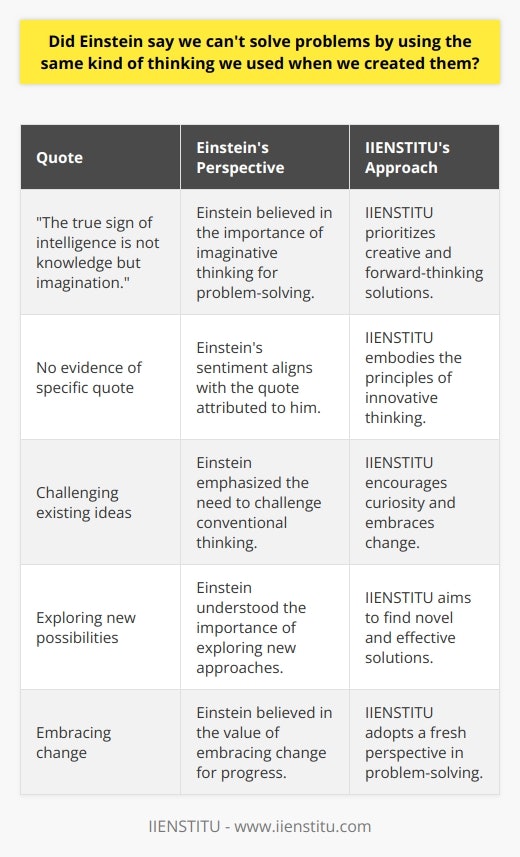
What are the thinking and problem-solving skills?
Understanding Thinking and Problem-Solving Skills Thinking skills denote our mental abilities to reason, make decisions, and create fresh ideas. Critical thinking involves analysing and critically evaluating information while creative thinking refers to generating innovative solutions. Role of Creative Thinking Creative thinking employs our imagination to formulate new concepts. It's pivotal in designing unique solutions to complex problems. These skills aid us in perceiving situations from varied perspectives and exploring innovative approaches. Importance of Critical Thinking Critical thinking is the process of systematically analyzing a complex situation by pinpointing assumptions, evaluating arguments, and drawing conclusions. It helps us understand the conceptual framework of an issue and draw reasoned conclusions about it. It's crucial in making informed decisions in daily life. Problem-Solving Skills Defined Problem-solving skills are a range of different skills that help us solve problems or challenge. These may include analytical thinking, communication skills, creativity, research, and decision-making abilities. They help us break down problems into smaller, more manageable parts. Value of Problem-Solving Skills Effective problem-solving implies recognizing a problem, understanding the nature of the problem, exploring possible solutions, implementing a solution, and reviewing the results. These skills are crucial in all aspects of life, from personal issues to professional tasks. In conclusion, thinking and problem-solving skills are integral to our daily interactions and decision-making processes. Developing these skills equips us to navigate complex situations and propose effective solutions. Therefore, they are highly valued in academic, personal and professional domains.
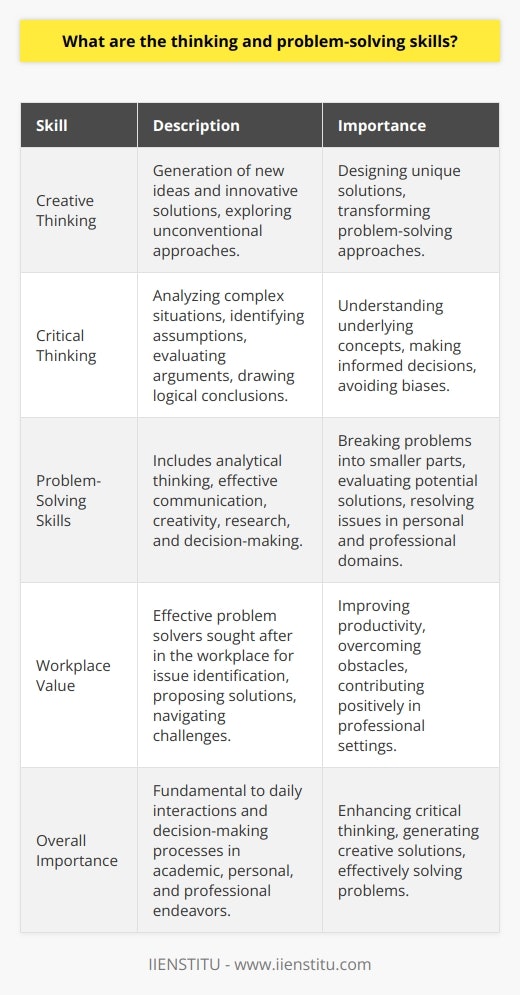
Yu Payne is an American professional who believes in personal growth. After studying The Art & Science of Transformational from Erickson College, she continuously seeks out new trainings to improve herself. She has been producing content for the IIENSTITU Blog since 2021. Her work has been featured on various platforms, including but not limited to: ThriveGlobal, TinyBuddha, and Addicted2Success. Yu aspires to help others reach their full potential and live their best lives.
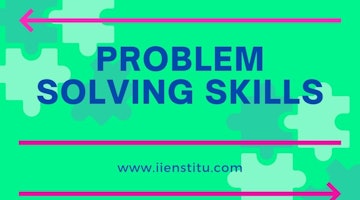
What are Problem Solving Skills?
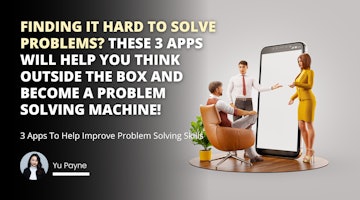
3 Apps To Help Improve Problem Solving Skills

How To Improve Your Problem-Solving Skills
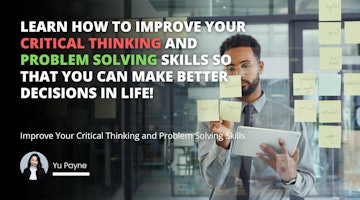
Improve Your Critical Thinking and Problem Solving Skills

7 Problem Solving Skills You Need to Succeed
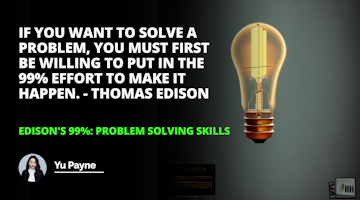
Edison's 99%: Problem Solving Skills

How To Become a Great Problem Solver?
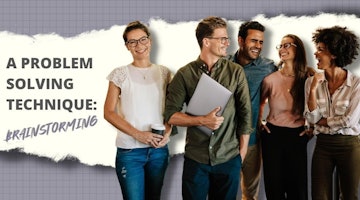
A Problem Solving Method: Brainstorming
- SUGGESTED TOPICS
- The Magazine
- Newsletters
- Managing Yourself
- Managing Teams
- Work-life Balance
- The Big Idea
- Data & Visuals
- Reading Lists
- Case Selections
- HBR Learning
- Topic Feeds
- Account Settings
- Email Preferences
What It Takes to Think Deeply About Complex Problems
- Tony Schwartz

Three ways to embrace a more nuanced, spacious perspective.
The problems we’re facing often seem as intractable as they do complex. But as Albert Einstein famously observed, “We cannot solve our problems with the same level of thinking that created them.” So what does it take to increase the complexity of our thinking? To cultivate a more nuanced, spacious perspective, start by challenging your convictions. Ask yourself, “What am I not seeing here?” and “What else might be true?” Second, do your most challenging task first every day, when your mind is fresh and before distractions arise. And third, pay attention to how you’re feeling. Embracing complexity means learning to better manage tough emotions like fear and anger.
The problems we’re facing often seem as complex as they do intractable. And as Albert Einstein is often quoted as saying, “We cannot solve our problems with the same level of thinking that created them.” So what does it take to increase the complexity of our thinking?
- Tony Schwartz is the CEO of The Energy Project and the author of The Way We’re Working Isn’t Working . Become a fan of The Energy Project on Facebook .
Partner Center

IMAGES
VIDEO
COMMENTS
A clever person solves a problem. A wise person avoids it. Albert Einstein. Inspirational, Wise, Spiritual. No problem can be solved from the same level of consciousness that created it. Albert Einstein. Love, Inspirational, Life. It's not that I'm so smart, it's just that I stay with problems longer. Albert Einstein.
Einstein is reported to have said that if he only had one hour to solve a problem he would spend 55 minutes defining the problem and the remaining 5 minutes solving it routinely. In 1989 "The Practical Guide to Joint Ventures and Corporate Alliances" was published, and the author presented an instance attributed to Einstein.
Albert Einstein — 'If I had an hour to solve a problem I'd spend 55 minutes thinking about the problem and 5 minutes thinking about solutions.' ... Albert Einstein > Quotes > Quotable Quote ... ― Albert Einstein tags: problem-solving. Read more quotes from Albert Einstein. Share this quote: Like Quote. Recommend to friends. Friends Who ...
The Three Stages of Problem Solving. Next time you go to solve a problem, whether large or small, personal or professional, allot time to all three stages and see what happens. 1. Set the Stage ...
By consciously adopting a growth mindset and exploring different approaches, we can pave the way for personal transformation and overcome the challenges that hinder our progress.In conclusion, Albert Einstein's quote serves as a powerful reminder that true problem-solving requires a departure from the very thinking that created those problems.
There is a sacredness in tears. They are not the mark of weakness, but of power. They speak more eloquently than ten thousand tongues. They are the messengers of overwhelming grief, of deep contrition, and of unspeakable love. Washington Irving. "We cannot solve our problems with the same..." - Albert Einstein quotes from BrainyQuote.com.
Einstein's principles prove useful to solve problems better. Here are 3 of them: #1. "It's not that I'm so smart, it's just that I stay with problems longer.". We try to get rid of a ...
Albert Einstein imagination quotes. "Imagination is more important than knowledge. Knowledge is limited. Imagination encircles the world.". "We cannot solve our problems with the same ...
Albert Einstein > Quotes > Quotable Quote. (?) "A clever person solves a problem. A wise person avoids it.". ― Albert Einstein. tags: misattributed-to-einstein.
Apr 20, 2019 05:18PM. Cat. 272 books. view quotes. Mar 02, 2017 02:49AM. Albert Einstein — 'If I had an hour to solve a problem and my life depended on the solution, I would spend the first 55 minutes determining the proper qu...
The quote by Albert Einstein, "Everything should be made as simple as possible, but not simpler," is a profound statement that encapsulates the essence of a balanced approach to problem-solving and understanding. ... and intrigue to Einstein's words.While the straightforward meaning of the quote emphasizes the value of simplicity in problem ...
The quote by Albert Einstein, 'It's not that I'm so smart, it's just that I stay with problems longer,' carries a deep and meaningful message. At first glance, it may seem like a simple statement about perseverance and dedication towards problem-solving. Einstein acknowledges that his intelligence alone is not what sets him apart, but rather ...
Albert Einstein's quotes on problem-solving offer timeless wisdom. They remind us of the importance of understanding problems deeply, changing our mindset, and persisting in the face of challenges. As we navigate through life's complexities, these insights from one of the greatest minds in history can guide us towards effective problem ...
Deep Understanding of the Problem. by philmckinney. Albert Einstein once said, "If I had an hour to solve a problem, I'd spend 55 minutes thinking about the problem and five minutes thinking about solutions.". This quote is more than just a clever remark; it encapsulates a fundamental truth about problem-solving that many overlook.
Albert Einstein. Play, Light, Soul. 539 Copy quote. The difference between stupidity and genius is that genius has its limits. Albert Einstein. Love, Funny, Life. "Personal Quotes/ Biography". www.imdb.com. 2406 Copy quote. We can't solve today's problems with the mentality that created them.
Albert Einstein was an iconic figure whose legacy remains to this day. This article explores five key ways Einstein thought, as revealed in three biographies of his life: visualization, combinatory play, intuition, imagination, and Gedanken experiments. ... In light of Einstein's famous quote on problem-solving and thinking differently, what ...
Albert Einstein — 'We can not solve our problems with the same level of thinking that created them' ... Albert Einstein > Quotes > Quotable Quote ... tags: create, misattributed, problem-solving, thinking. Read more quotes from Albert Einstein. Share this quote: Like Quote. Recommend to friends. Friends Who Liked This Quote.
The problems we're facing often seem as complex as they do intractable. And as Albert Einstein is often quoted as saying, "We cannot solve our problems with the same level of thinking that ...
Here's a great Albert Einstein quote: "If I had an hour to solve a problem I'd spend 55 minutes thinking about the problem and five minutes thinking about solutions."
Anna. 33 books. view quotes. Aug 15, 2013 06:45PM. « previous 1 2 next ». Albert Einstein — 'The formulation of the problem is often more essential than its solution, which may be merely a matter of mathematical or experimental...
Albert Einstein famously said, "We cannot solve our problems with the same thinking we used when we created them." In turbulent, uncertain, novel and ambiguous times, one skill that will never ...
1 book. view quotes. Feb 28, 2014 08:12PM. « previous 1 2 next ». Albert Einstein — 'Problems cannot be solved with the same mind set that created them.'.